
| Preface | Perth | Stuart Highway | Uluru | Port Douglas | Sydney | Sturt Highway | Kangaroo Island | Indian Pacific | Perth |
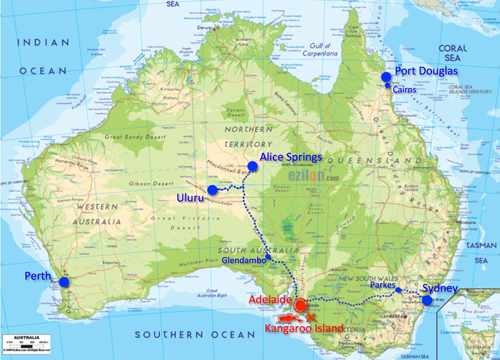
The Regional Express puddle-jumper to Kangaroo Island had a checked-bag weight allowance that most flights apply to carry-on. So the carrier did a steady business charging to store the rest of your luggage until you returned. The carry-on was then stowed by hand as we took the short walk across the tarmac and on to the small turbo-prop. The cabin crew was a large and cheerful young man who squeezed up and down the aisle to do a quick lapbelt check and hand out a few bottles of water and we were off. The flight was a mercifully smooth straight up and straight down, no cruising. 25 minutes. Done. The control tower at Kingscote Airport was so small I don't think our guy would have fit in it. It was more of a shed than a tower, painted white and red to make it seem important. Needless to say it was empty.
The terminal was to the same scale, but nevertheless held everything one could need: the small waiting area (no check-in counter or security of course); a coffee counter; a car rental office; and incredibly, a tourist office. The tourist officer excelled at his job, making conversation with us as we waited for the car rental guy to free up. He had answers for everything, up to and including not just where the gin distillery was, but an opinion on their offerings. He sold us a map of the island which Claudia loved so much that later when Bailey chewed a hole in it Claudia wrote to him and got him to send us another copy.
It was still early afternoon, and there were two or three hours left before we needed to be at the homestead for dinner. A perfect time to knock off some of the second tier todo's that we might not have time for later. Like the gin distillery to name one purely at random, conveniently located directly between Kingscote and Stranraer Homestead, our B&B for the next three nights.
On the outskirts of town a large sign indicated the current fire danger. It was a typical sign except that the most dangerous condition was "Catastrophic". Even more alarming, the sign noted that the last catastrophic fire was on December 10 2007—since Wayne and I were here in 2005. We were to see evidence of the devastation later in the trip.
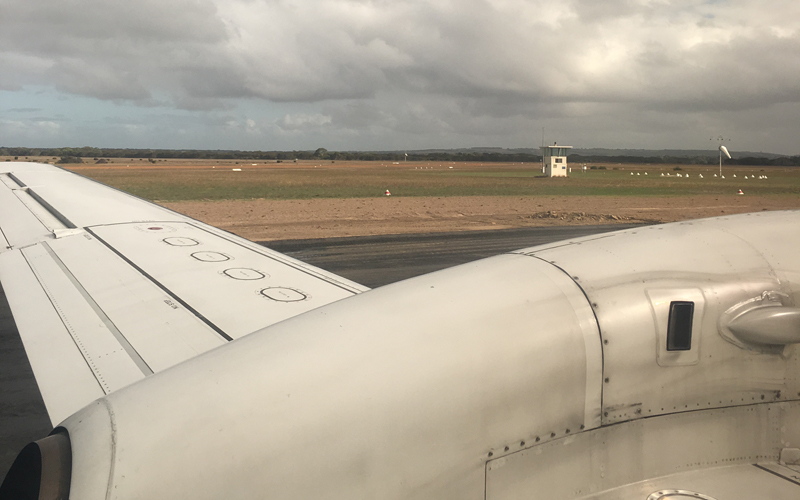
The Kangaroo Island Spirits distillery (KIS) was an appropriately ramshackle compound of dusty wooden huts, the largest of which served as the gift shop/tasting room. I went with KIS O'Gin, described as a small batch Australian gin distilled with native juniper and local daisy foraged from the Kangaroo Island coast, along with coriander and angelica root. Not particularly smooth, but made a great gin and tonic and a great souvenir. To Claudia's relief, the no-nonsense approach and small number of offerings meant that we were in and out in 15 or 20 minutes, but time well-spent.
Next stop ironically was another distillery, but one more to Claudia's liking, the Emu Ridge Eucalyptus Oil Distillery. Back in 2005, I had spent a huge percentage of my total souvenir budget in this lovely little gift shop so I had high hopes for it this time around. The good news is that it had not changed a bit. The bad news is that it had not changed a bit. Part of me was comforted that in this fast-paced world, this little oasis was standing still. Occasionally, just occasionally, you can go back. We did buy some little pots of soap and oil for gifts, and they still had the big print of the Remarkables and the emu eggs, one of which I so carefully coddled all the way home, but I had those already. There was nothing new to excite the wallet. In despiration, I bought a plastic platypus, to be replaced sometime never. A tour bus arrived as we were leaving, reminding us what a privilege it was not to be queuing for the operator to dole out a eucalyptus candy each as we filed passed like patients at the dispensary. The current batch of patients made their way to the benches in the little viewing room where the ancient three minute eucalytpus distilling documentary would eventually be turned on. We scurried out to the car.
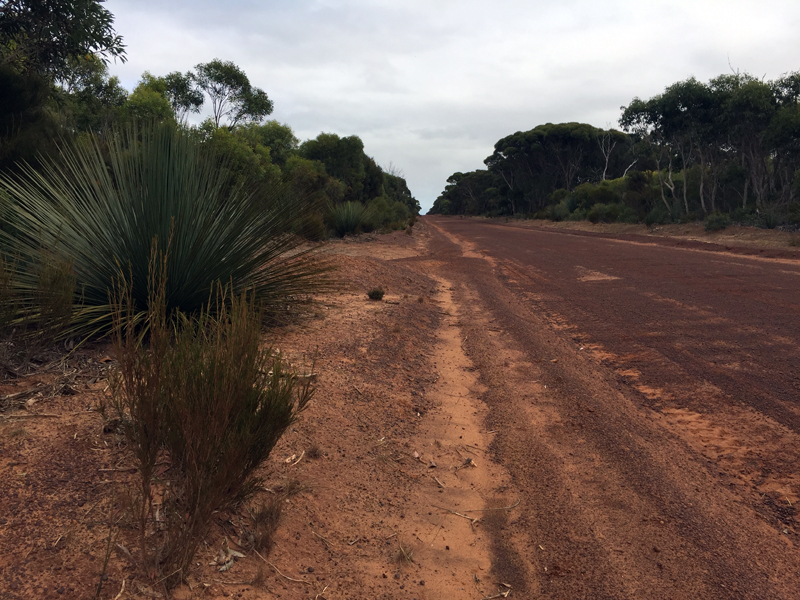
It was time to look for Stranraer. Not hard because the instructions were clear and accurate (for a change) but it sure was in the middle of nowhere. As soon as we got close it became clear that it was the center of something because we had to drive around the full-sized cricket oval to approach the house. The pitch itself had been dug up apparently "so that it can be laser-levelled." (Cricket is equivalent to baseball, one difference being that the batsmen run back and forth between just two bases (the pitch) instead of around four, and those bases are in the middle of the field, not on one corner. The ball is projected from "first base" back to "home plate" and generally bounces once before arriving at home plate. Hence the desire for it to be as flat as possible.)
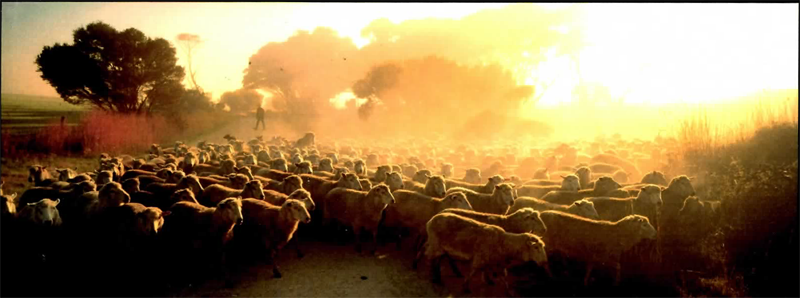 Graham Wheaton and his flock. Based on the stunning original hanging in the hallway at Stranraer Homestead. Graham Wheaton and his flock. Based on the stunning original hanging in the hallway at Stranraer Homestead. Reproduced by kind permission of Lyn and Graham Wheaton. December 2017 |
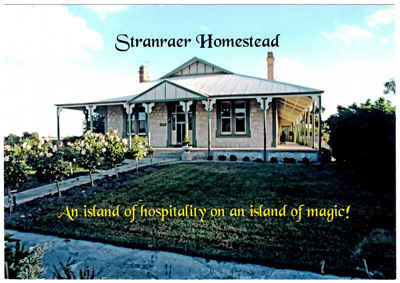 Clearly ancient postcard but nevertheless a good likeness. Clearly ancient postcard but nevertheless a good likeness. |

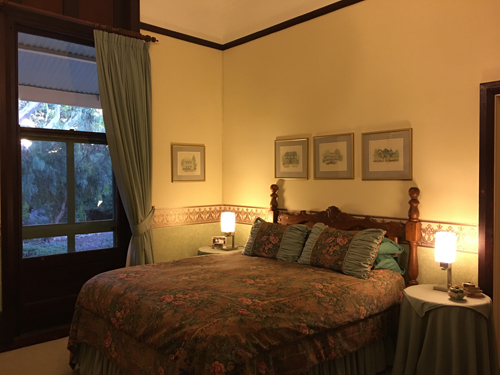
Finally pulling up in front of the homestead, it looked exactly as one might have imagined it: "an historic federation homestead built in 1920 from limestone gathered on the property." A flock of galahs (rose-breasted cockatoos) squabbled over prime real estate in the tree overhanging the parking area. We pushed open the front door as instructed, and were half way down the corridor when Lyn poked her head around the corner. We were instantly made to feel at home. Lyn and Graham had a wonderful way of supplying each other's needs without ever needing to ask, allowing the work to get done quietly while they simultaneously chatted with the guests. Tragically, Graham was starting to suffer from MS, and now walked with arm crutches, so it was obviously starting to take its toll on what he was able to do, but he still delighted in showing us around the garden that afternoon not least because there was a koala in the tree outside our window which we absolutely needed to see.
As it says on their website "Lyn’s meals provide the best of Kangaroo Island produce wherever possible and with a fresh menu daily. It is a delight to discover what awaits!" Her own cookbook was available for purchase.
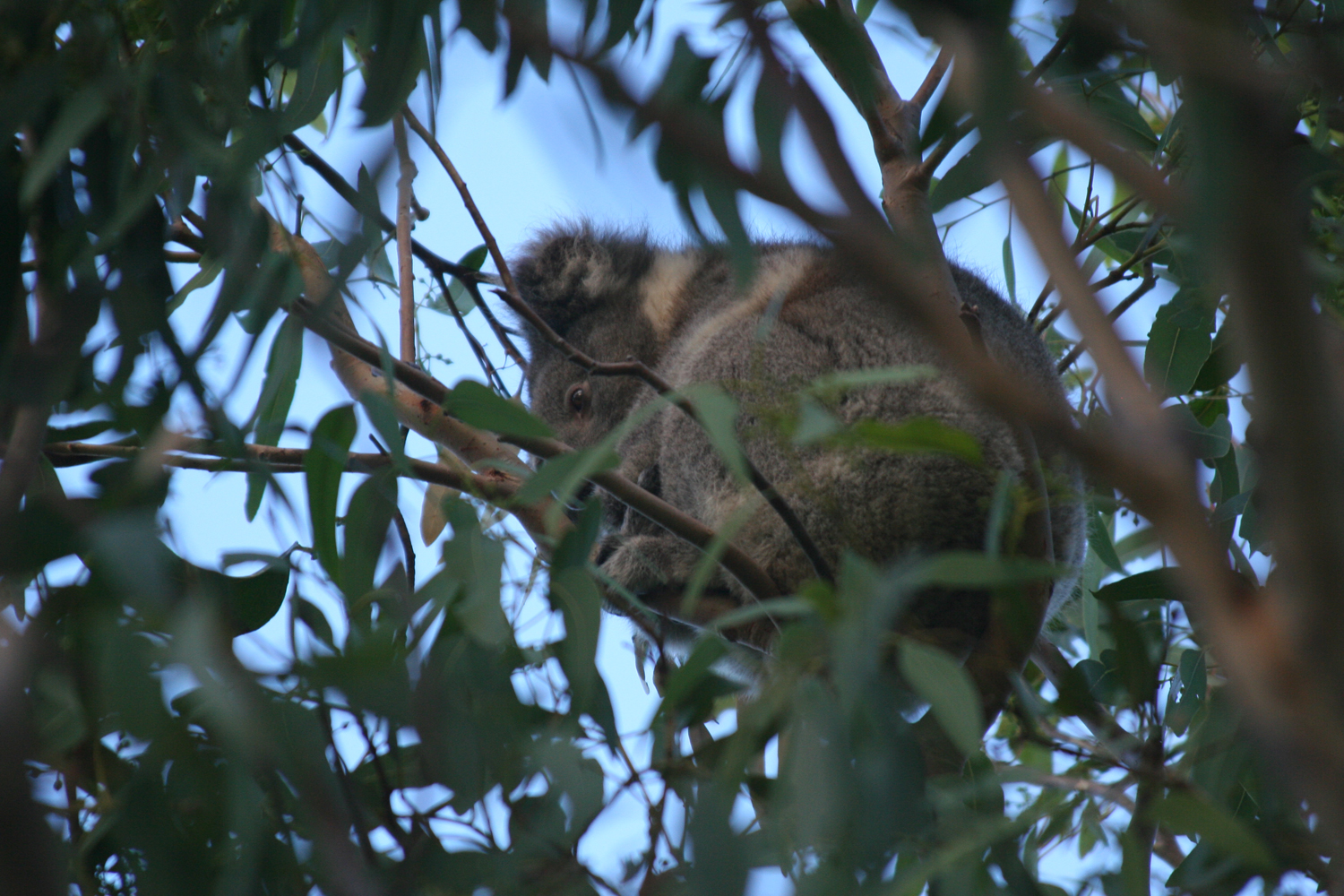
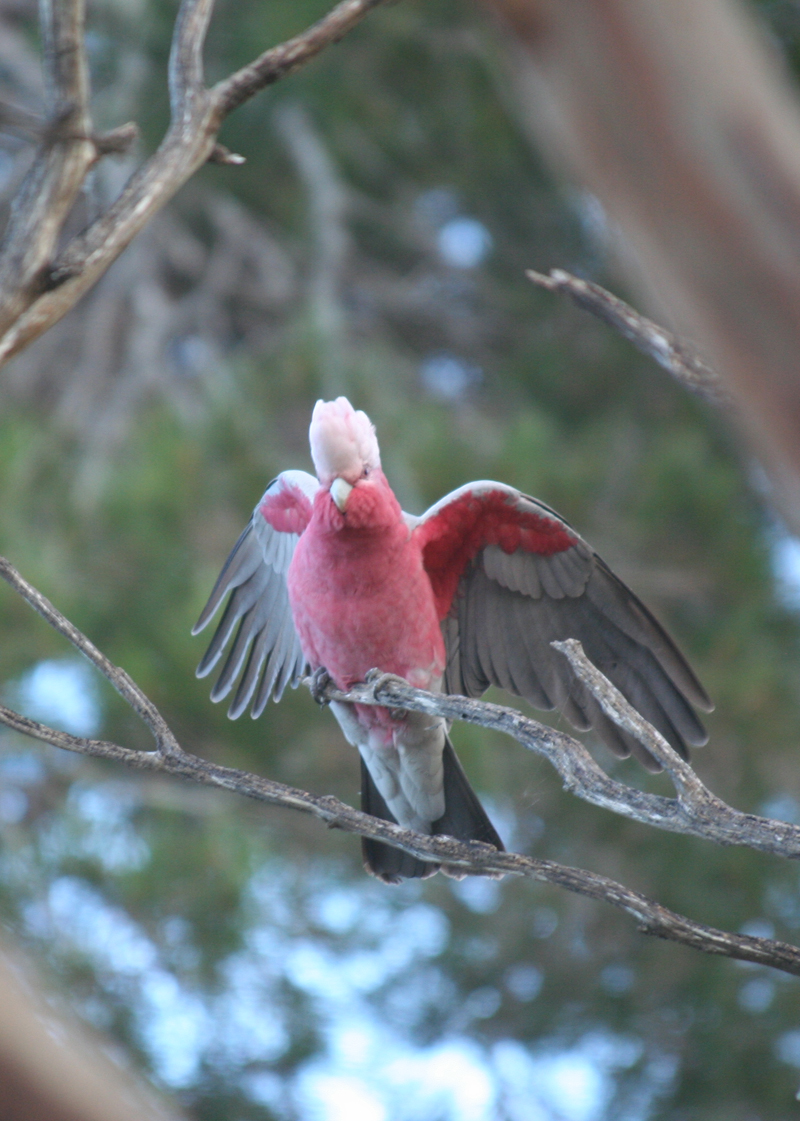 |
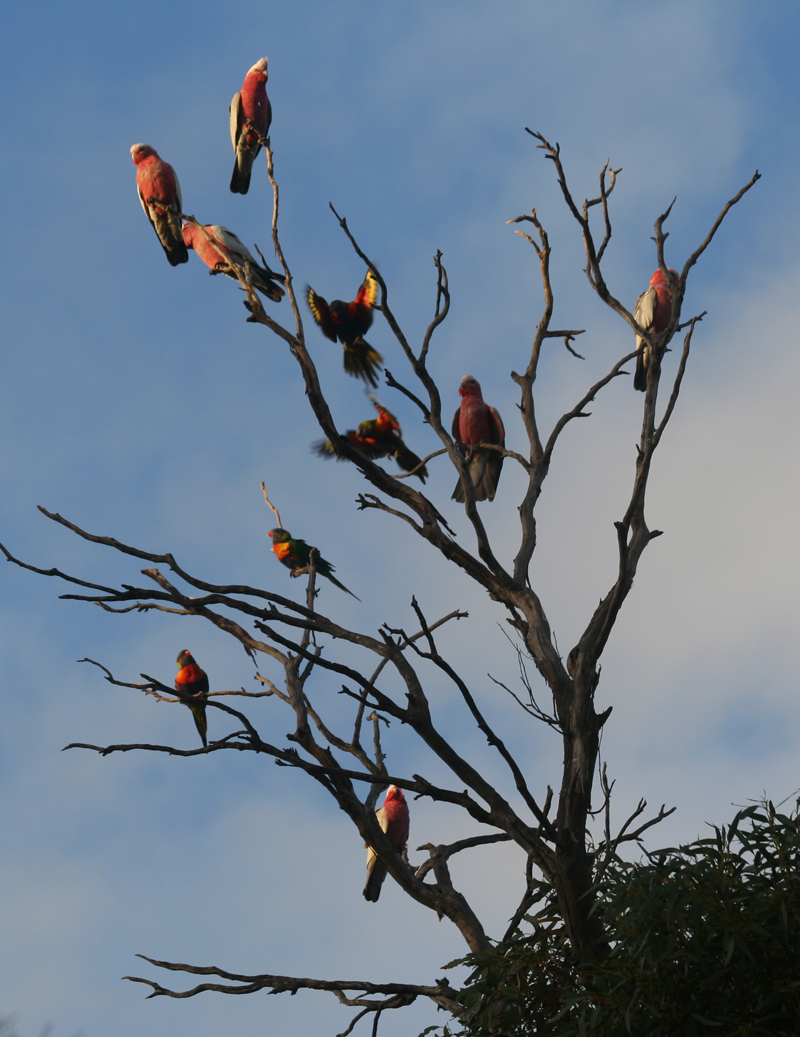 The galahs in their favorite tree. And if I'm not mistaken, that's a couple of rainbow lorikeets relagated to the lower left branches. The galahs in their favorite tree. And if I'm not mistaken, that's a couple of rainbow lorikeets relagated to the lower left branches. |
Day 1: Public Tour
The plan for KI was to spend the first day redoing all the things I knew and loved from my last visit, and then have our local guide spend the second day showing us both things we could not see on our own as regular tourists. First thing, a morning stroll around the garden, and in particular a check to see if the koala was still there from last night's sighting. Check. Then came a spectacular B&B breakfast of homemade compots, scones, and other cold things, and just when we were getting full our hostess announced the hot food. There were two other couples as well as plenty of chat and opinions from our hosts. The other guests had their own guided tour scheduled, and as soon as they were gone we packed up and set off. We wanted to try marron, the famous local shellfish, and Lyn strongly advised us to avoid the "overrated" restaurant that specialized in it, and instead we should go to the chippy in town who always had it. So clearly we needed to end up there for supper. Then back in time for Graham's special treat: an evening drive around the farm to spot some after-dark-fauna. I made Graham promise not to leave without me, no matter how long the marron delayed me.
Seal Bay
First stop was Seal Bay. The Visitor Center seemed about twice the size I remembered, and the board walks were definitely twice the length. We were in plenty of time for the next guided tour—an essential requirement if you actually wanted to get down onto the beach and up close and personal with the sea lions. We used the time to stroll down the new boardwalk. The whale skeleton Wayne and I had seen from a distance was now close enough to the extended walk that it had its own plaque. The plaque answered all the questions we'd had back in 2005. The skeleton is the remains of a juvenile humpback whale that washed up after a winter storm in 1984. It is likely that it became separated from its mother during migration. Humpback and southern right whales pass by Kangaroo Island during May to October on their annual migration to breeding grounds.
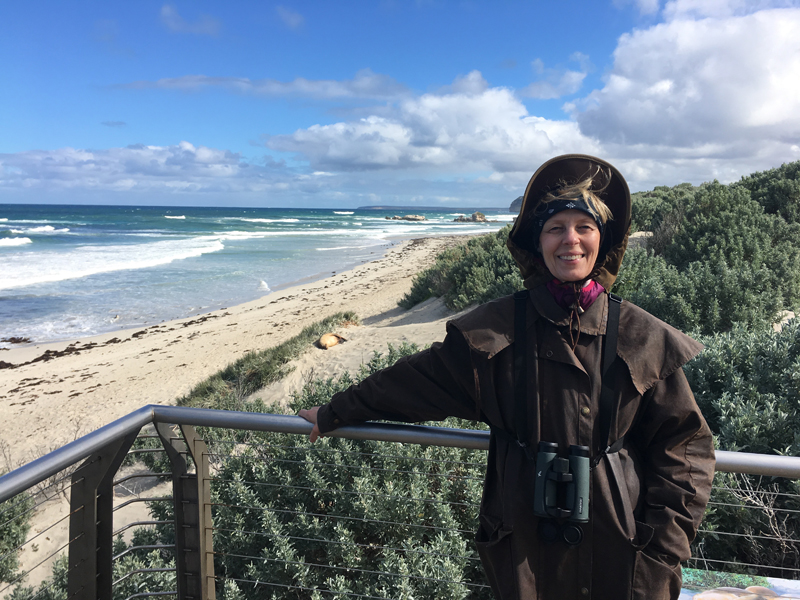 The boardwalk continued, in fact it ended pretty much on the beach.
The boardwalk continued, in fact it ended pretty much on the beach.
Back in the Visitor Center, we were just done congratulating ourselves on how small the group that assembled for the guided beach tour appeared to be, when it was doubled by the sudden appearance of half a dozen what-we-assumed-to-be Chinese additions glommed on to our group. We were not exactly going into the wilderness, but by any standards they were ill-equipped, with high heels for some of the women, and city slicker winkle-pickers for the men. We were not only wearing the fleeces and coats we'd brought with us, but the Aussie Sheep Farmer overcoats Lyn and Graham had insisted we borrowed from them. They were in open button-down shirts and billowy blouses. Best of all, the only one who spoke English wanted the guide to wait between sentences so that he could translate to the rest of his party. They quickly began even to irritate the obviously normally laid back and patient guide, as they drifted off or lagged behind despite his best efforts to keep us together. This was excellent, because knowing he knew it was a problem somehow calmed Claudia down sufficiently that she was able resist the urge to throw them over the side of the boardwalk.
The sea lions were scattered throughout the dunes, which I don't remember them doing before, but the main group was hanging out on the beach as advertized. We stood for quite a while just watching the pups horse around together, and a couple of adults washed in after their three or four day trip out to sea. They looked tired because they were, as they slowly waddled up the beach looking for a suitable spot to park for a well-earned nap. It started to rain, and one of our friends turned for home, but was stopped in his tracks by the guide "You are not permitted to leave the group, and I'm not permitted to bring the group back until our time is up. You must stay here." I felt a rather unpleasant mixture of sorry for the guy who was obviously bored, and even more obviously cold, along with a darker satisfaction that he, not we, paid the price for his lack of preparation.
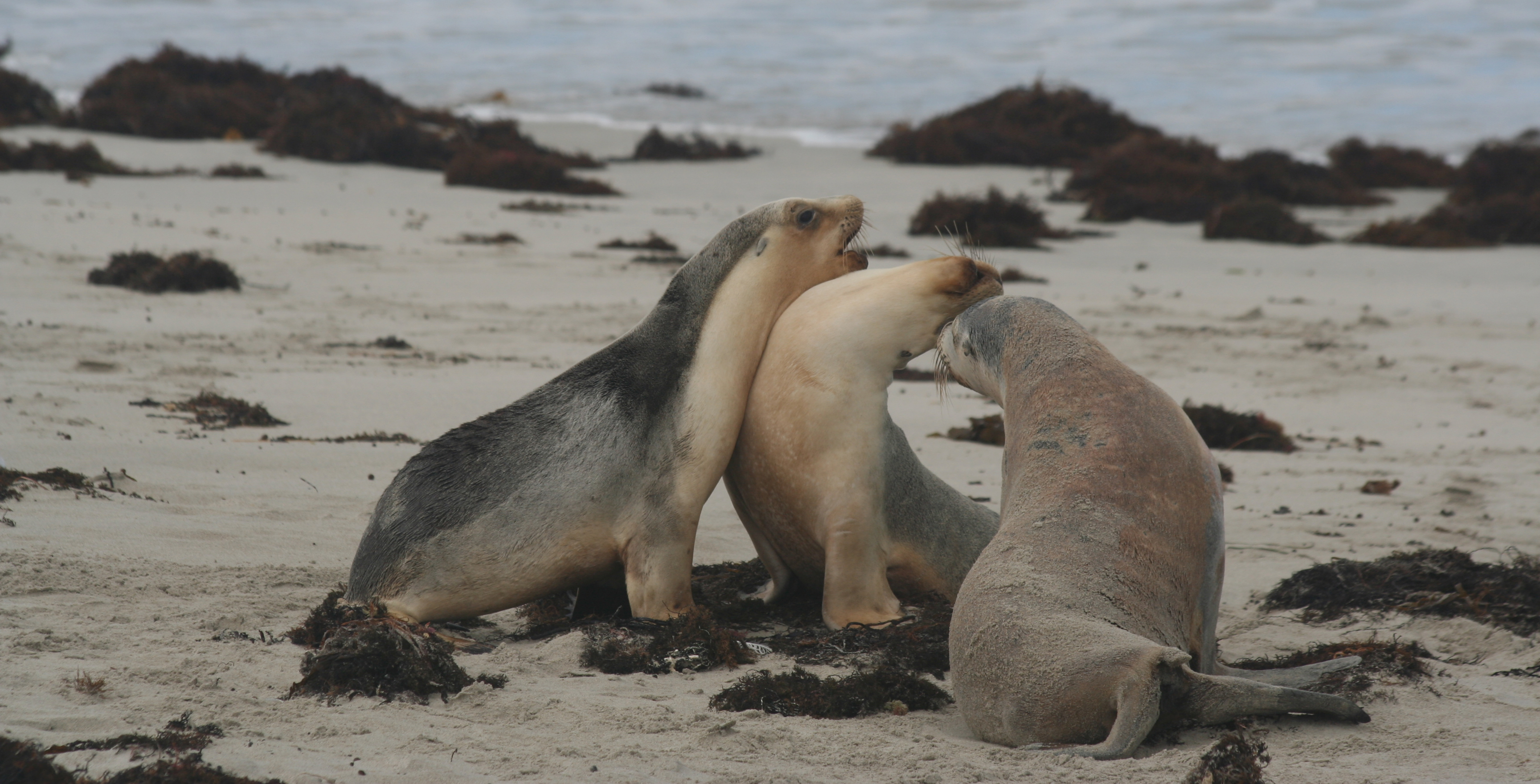
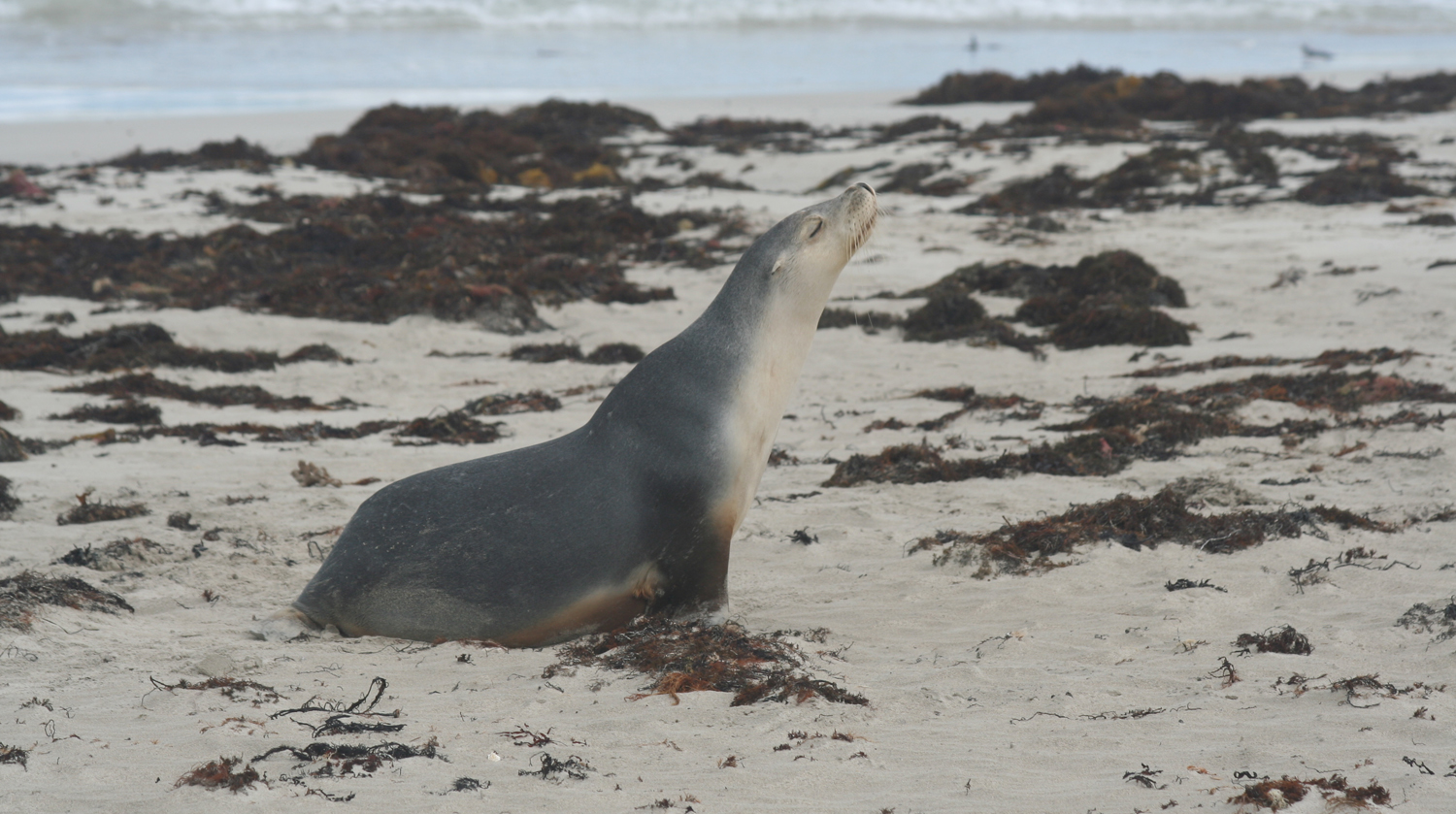
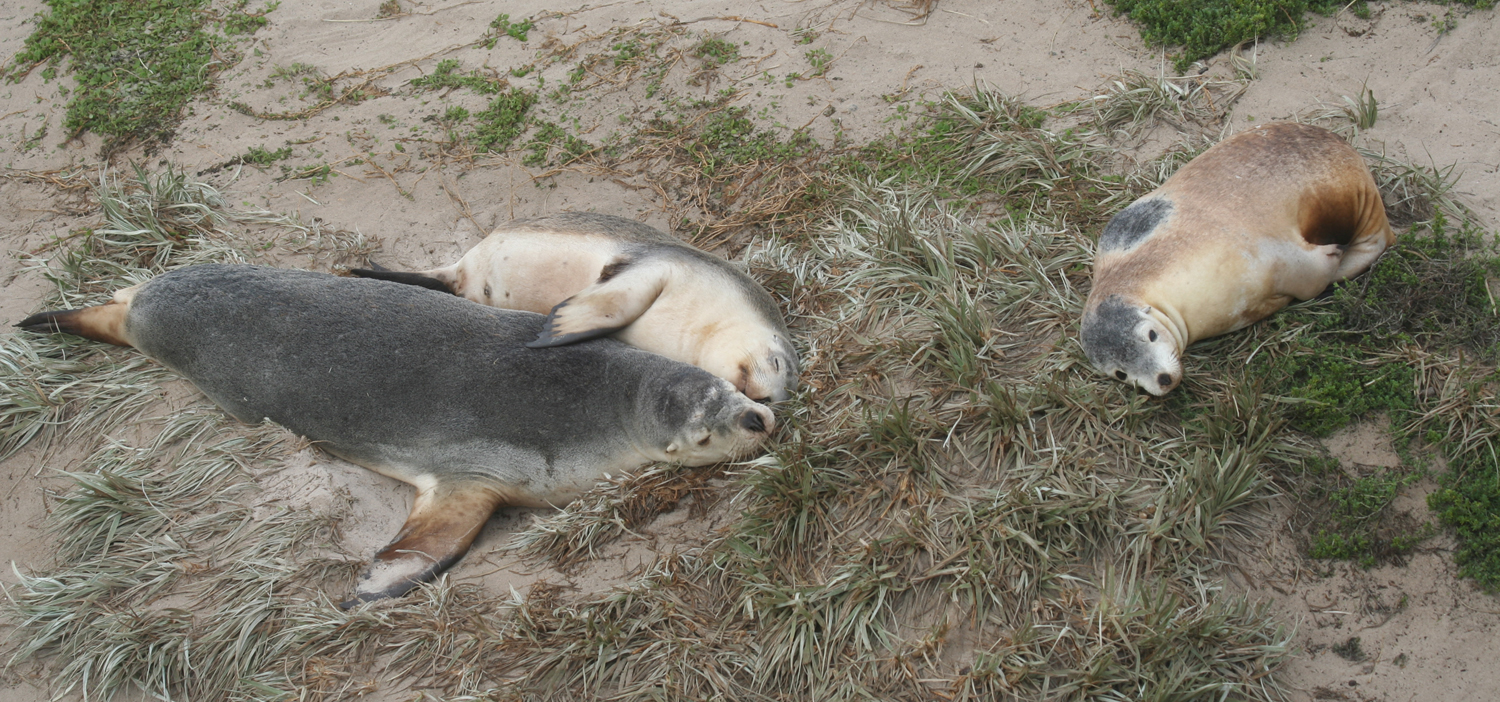
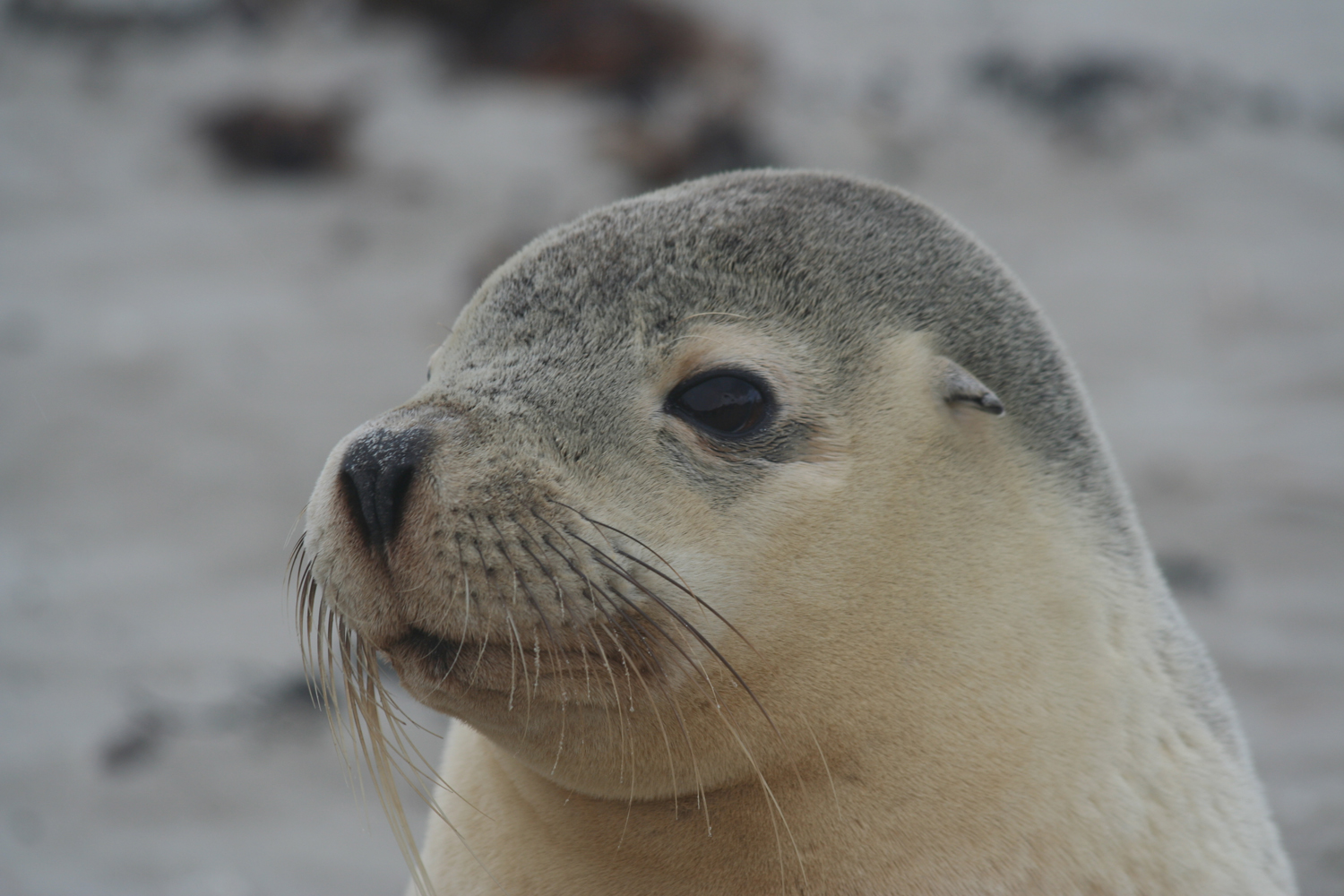
We were not allowed to approach the animals, though the whole point of the guided group was to get us pretty close, but if they approached us of course that's a whole different story. Eventually this pup was almost close enough to touch before I pulled the trigger on the shot.
Hanson Bay Wildlife Sanctuary aka Koala Park
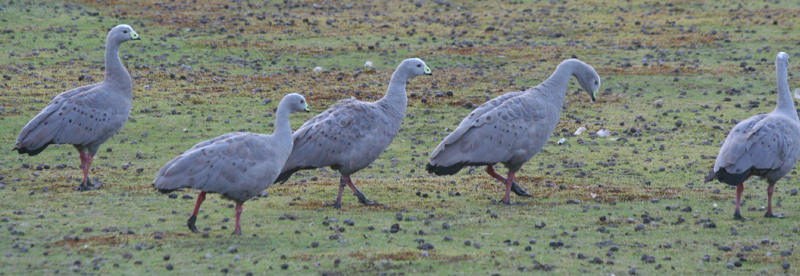 Cape Barren geese. I have come across these birds multiple times, and always with this same poop-plastered background—to the point where this is what
Cape Barren geese. I have come across these birds multiple times, and always with this same poop-plastered background—to the point where this is what allows me to identify them so confidently.
Next stop was the koala park, also from the 2005 visit. Bizarrely, it was part of a trailer (caravan) site but it was free, and it worked. This time I couldn't find the trailer park, never mind the koalas. Miraculously, near the spot we were looking, but on the other side of the road, was the Hanson Bay Wildlife Sanctuary which I swear was not there before, and it specialized in, you quessed it, koalas. What were the odds that these were not the self-same animals, or at least their decendants?
The main building and its parking lot were set back from the main road and the paddock in between was being maintained to golf green perfection by a flock of Cape Barren geese.
The sanctuary had a more substantial fence than I remembered for the previous enclave, apparently warding against feral cats which have had a disasterous affect on the island's smaller mammals (one of Lyn's pet peeves). We strolled slowly along the avenues of eucalyptus trees, stopping to peer especially hard up into the leaves and branches of trees marked with a road traffic cone, implying someone was home. The combination of fence and the broad paths between the trees lent something of an artificial air to this "natural" setting, but I'm not sure it mattered much: koalas are picky about the type of gum leaves they eat (and get high from) but that's about it. We found at least half a dozen, and got good views especially through our bins, but the pictures were none as good as the couple of shots we'd already captured of the one outside our window.
Back at the entrance, a cafe sported an excellent selection of desserts and sandwiches, and even a hot menu of fish and chips or cheeseburgers. Classic Australia: very unassuming, but providing everything you needed, and always fresh and appetizing-looking. We couldn't resist kaffee und kuchen, especially as they had something gluten-free. The coffee revolution had reached KI and the cappuchino and expresso-machine-made long black were perfect.
Flinders Chase
Flinders Chase is a huge park that occupies most of the western end of the island. In addition to a network of hiking trails, it protects two of Kangaroo Island's most famous / popular attractions, Admiral Arch and Remarkable Rocks. Although both somewhat "been there and done that" you really haven't been to Kangaroo Island until you have done that, so Claudia needed to see them. Plus Remarkable Rocks was one of my favorite spots from the 2005 trip, memorialized by the poster hanging in my home office.
There are no guards or gates, but there are large fines for not having a permit, and large signs for how to gain said permit, so there was a steady line of foot traffic from the shady parking lot to and from the Visitors Center. It also included a huge gift and souvenir shop where I had high hopes for finding my wooden platypus or koala or kangaroo but instead was confronted with the largest display of tacky plastic-tat-manufactured-thousands-of-miles-from-here. It took less than two minutes to verify that there was no secret corner of more imaginitive fare, then we paid our fees and moved on. By stark contrast, there is almost no information worth scraping from the park website because with the notable exception of the two features we planned to visit, and the old lighthouse facility where Wayne and I had lodged in 2005, the whole park consisted of, well, a whole lot of nothing. That's rather the point. It is a pristine block of countryside preserved in its natural state. A few paths criss-cross it, and about a day's hiking apart there are camping facilities, but otherwise the flora and fauna is left to its own devices. "Attractions include wild beaches, the unspoilt Rocky River, vast wilderness areas and cultural heritage sites."
Admiral's Arch
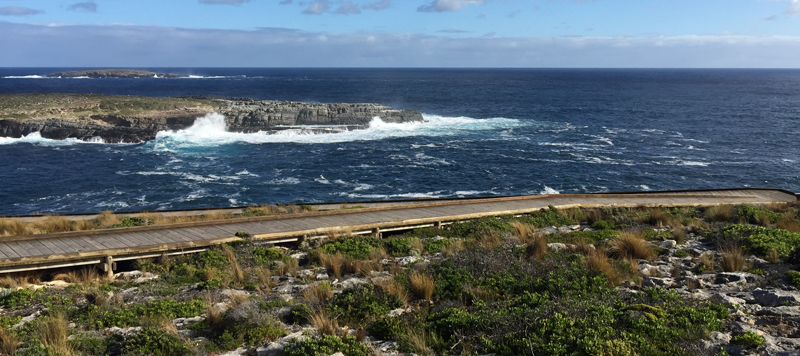
The main road meanders more or less in the direction of Admiral's Arch, where it terminates shortly after bypassing Cape Du Couedic Lighthouse, and a couple of miles before that a turn off leads a short distance down to The Remarkables. Admiral's Arch was exactly as I'd left it, 50ft crashes of water engulfing the cliff walls to the islands just off-shore as the ocean rollers pounded against them. A boardwalk protected the scrubby herbs, bushes and grasses, and lead all the way from the parking lot to the headland, and then cut back down the cliff to reveal the arch underneath our starting point.
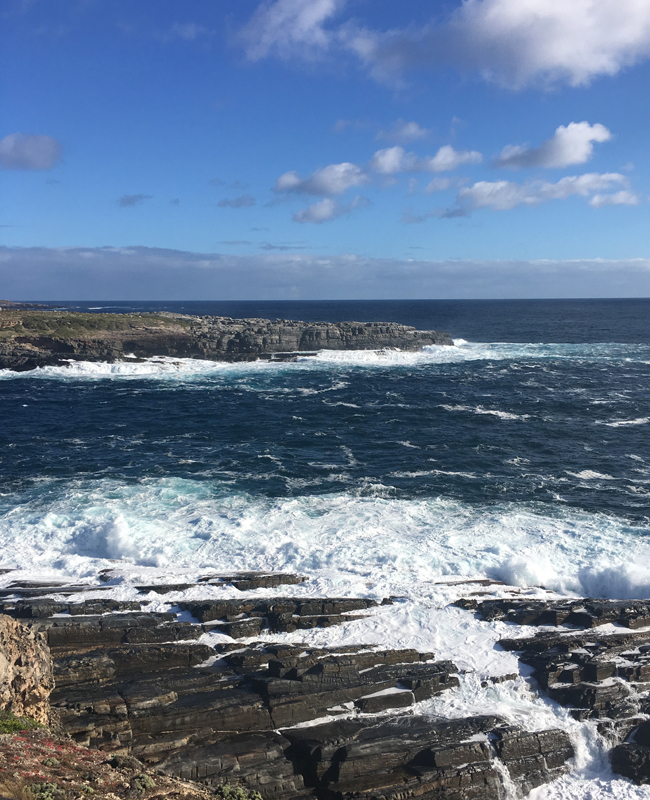 |
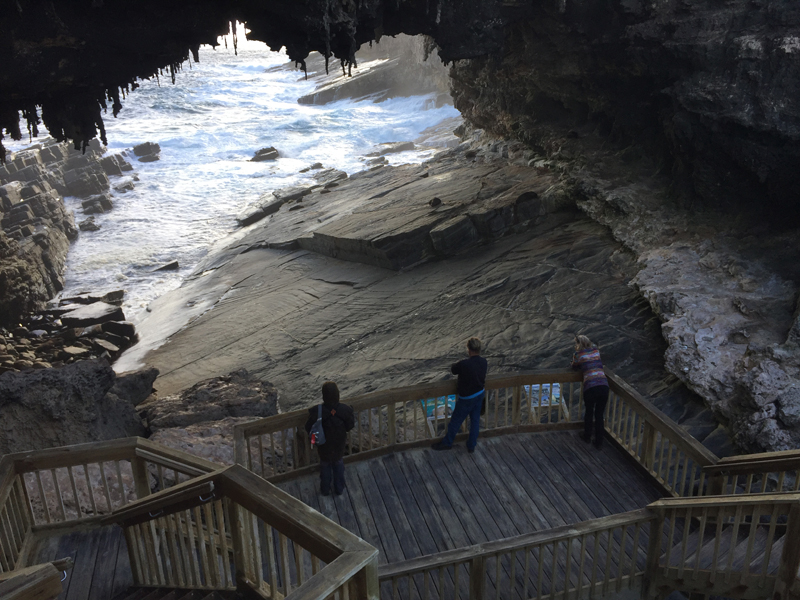
|
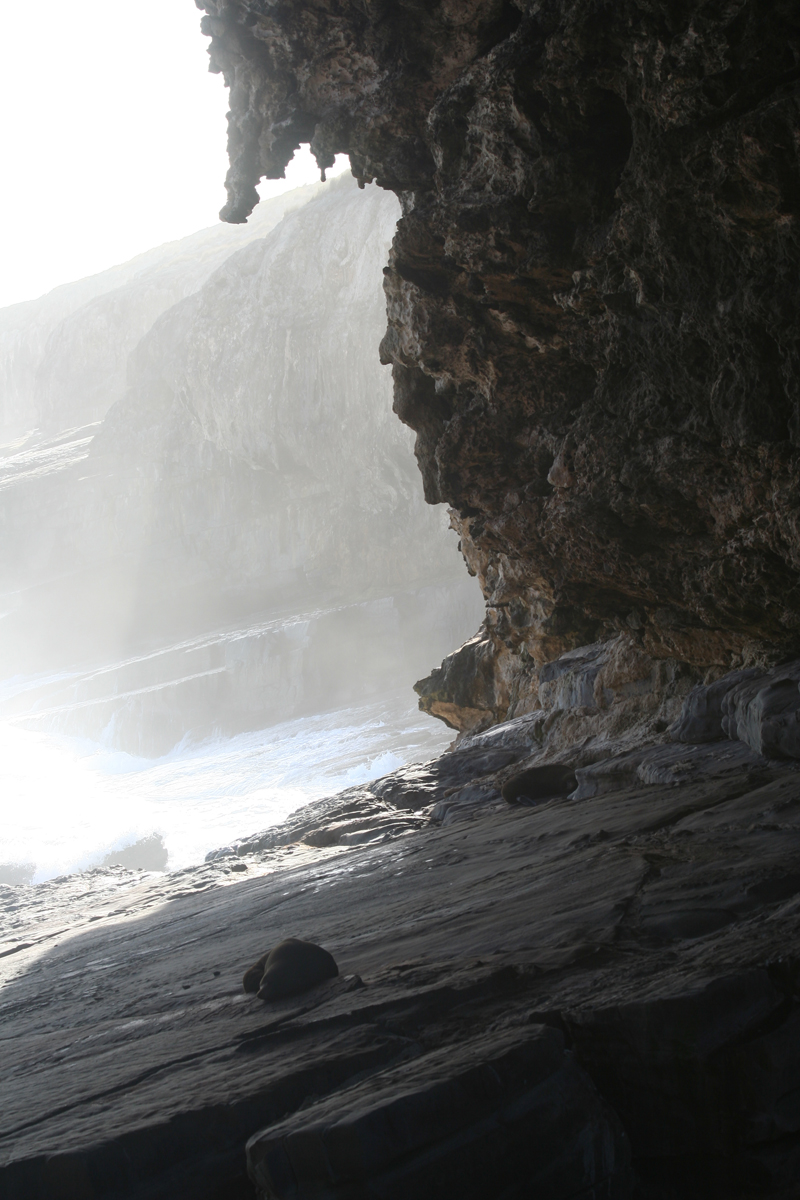
As soon as we started the descent we could see members of its famous New Zealand fur seal colony everwhere. Piled up together or solo napping, under the stairs or precariously close to the edge, with long drops to the sea, or worse, to some other rocky ledge. It was a mystery how they got up there, but clearly not to them because everyone seemed to have their own favorite spot. The steps end in a series of platforms giving a magnificent view of the arch. Stalactites dangle from the rocky ceiling of the former cave but the floor, conveniently, is very smooth allowing the seals plenty of additional snoozing space and presumably reasonable access to the water.
The Remarkables
At Remarkable Rocks we again followed a boardwalk down from the parking lot all the way to the main attraction. It took 500 million years for rain, wind, and pounding waves to create these aptly named granite boulders. At the base of one of the larger rocks we found a group of fellow visitors had set up camp, so even if you were patient enough to wait for none of them to be in the shot, their bags and boots were still cluttering up the view, which annoyed some of us more than others. It was an interesting group of about a dozen women all in their 20-somethings. Clearly hikers, they also seemed to have a support bus because to my considerable surprise the pack leader was providing a choice of refreshments: tea or gin and tonics. The latter was a very popular choice. Even more impressive, there was actually a choice of gin and best of all, the choices were Hendricks or the local island product: a very nice touch. We dodged around the ladies for a while, and eventually they put their boots back on and cleared the way. We had two or three minutes to ourselves and then when the next couple arrived we afforded them the same pleasure by vacating as they stepped onto the rock.

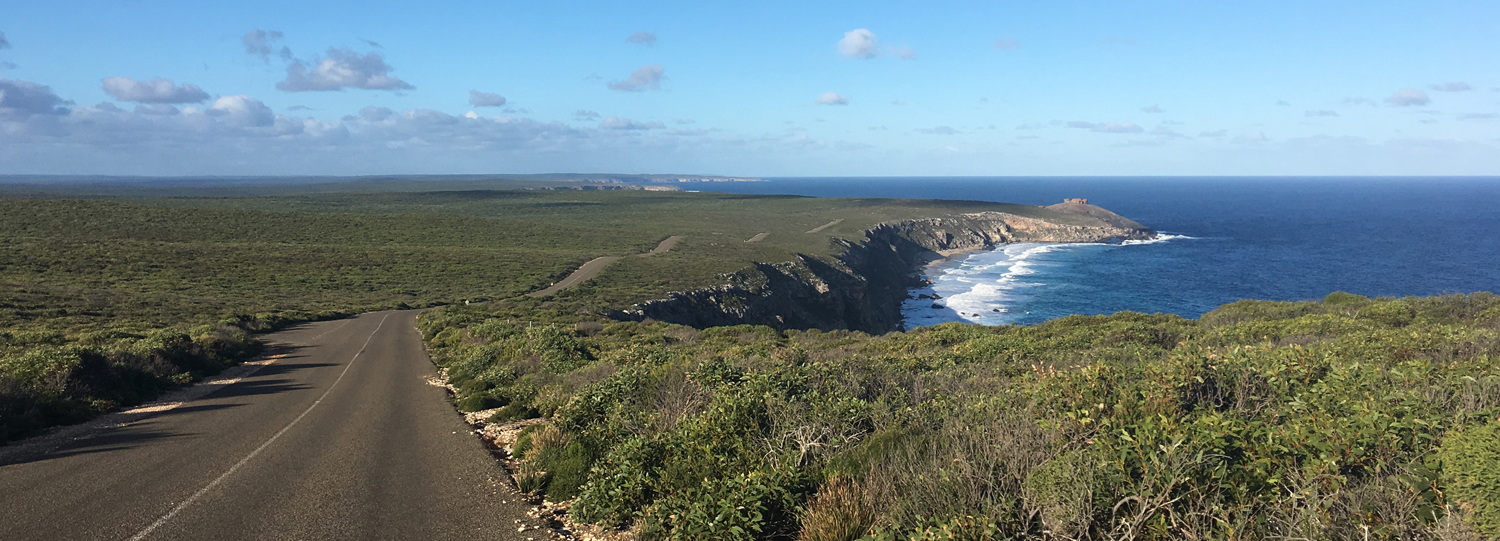
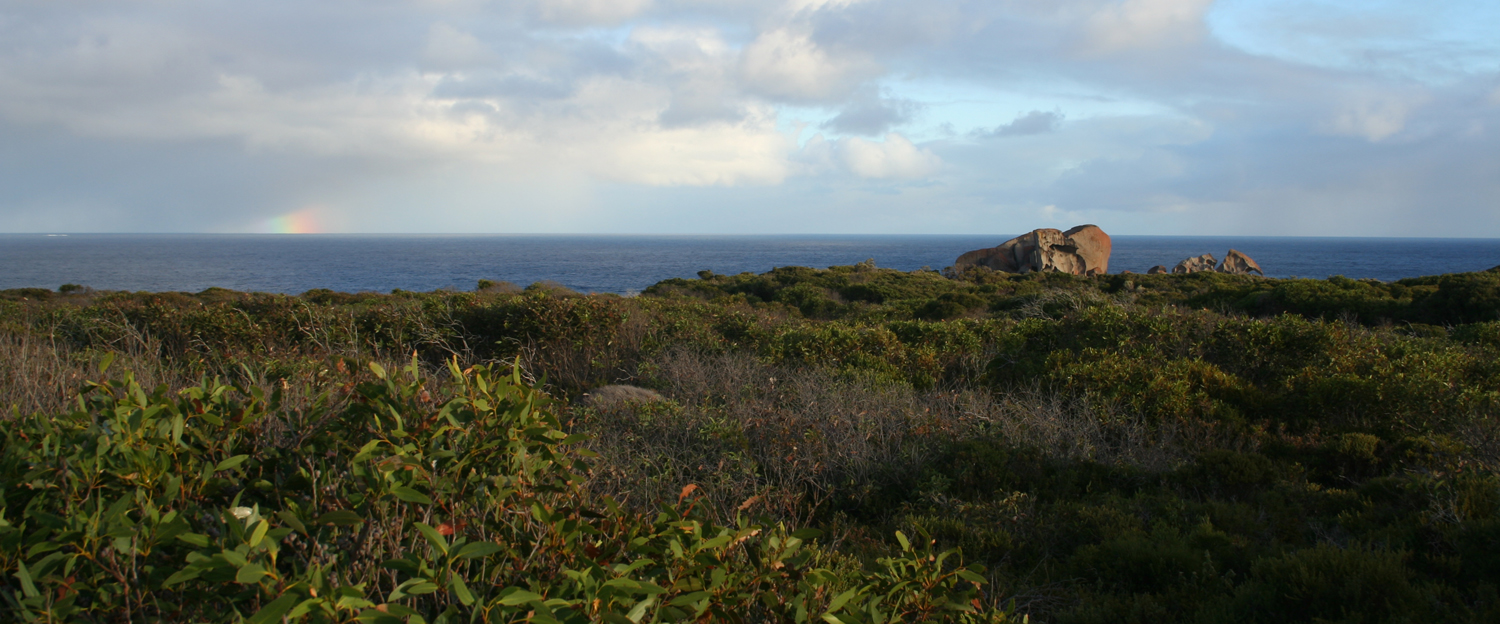
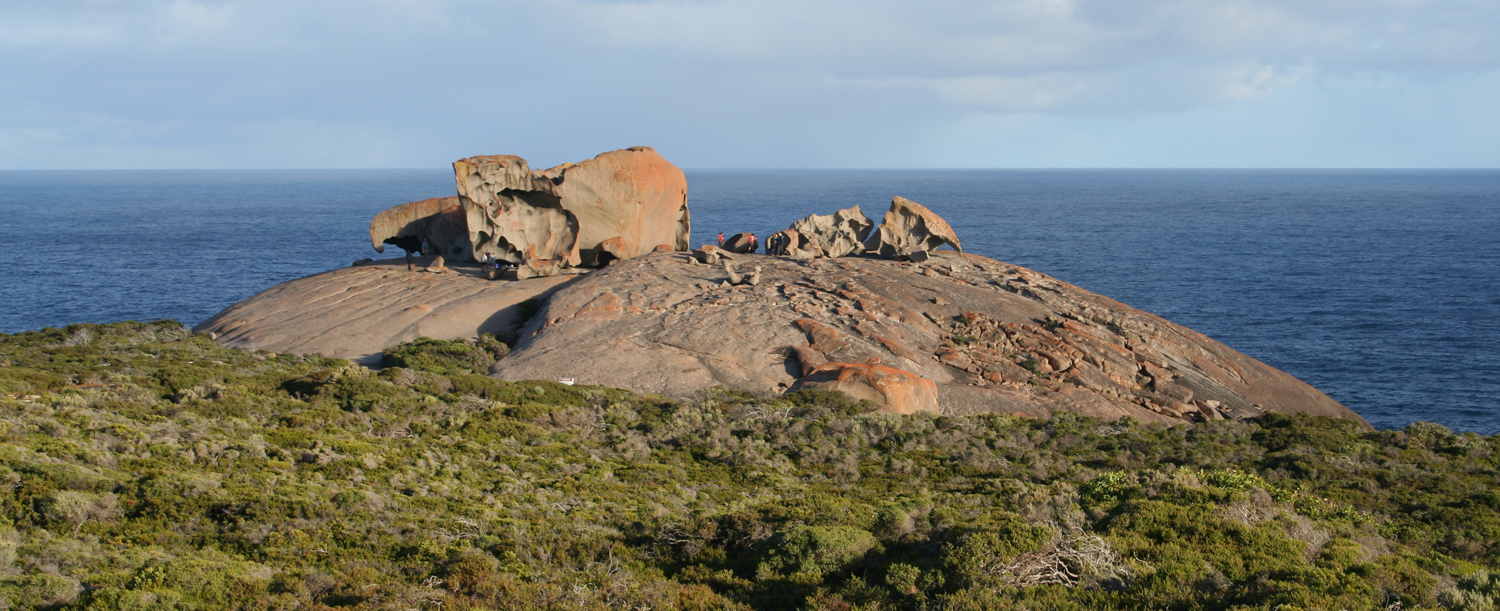
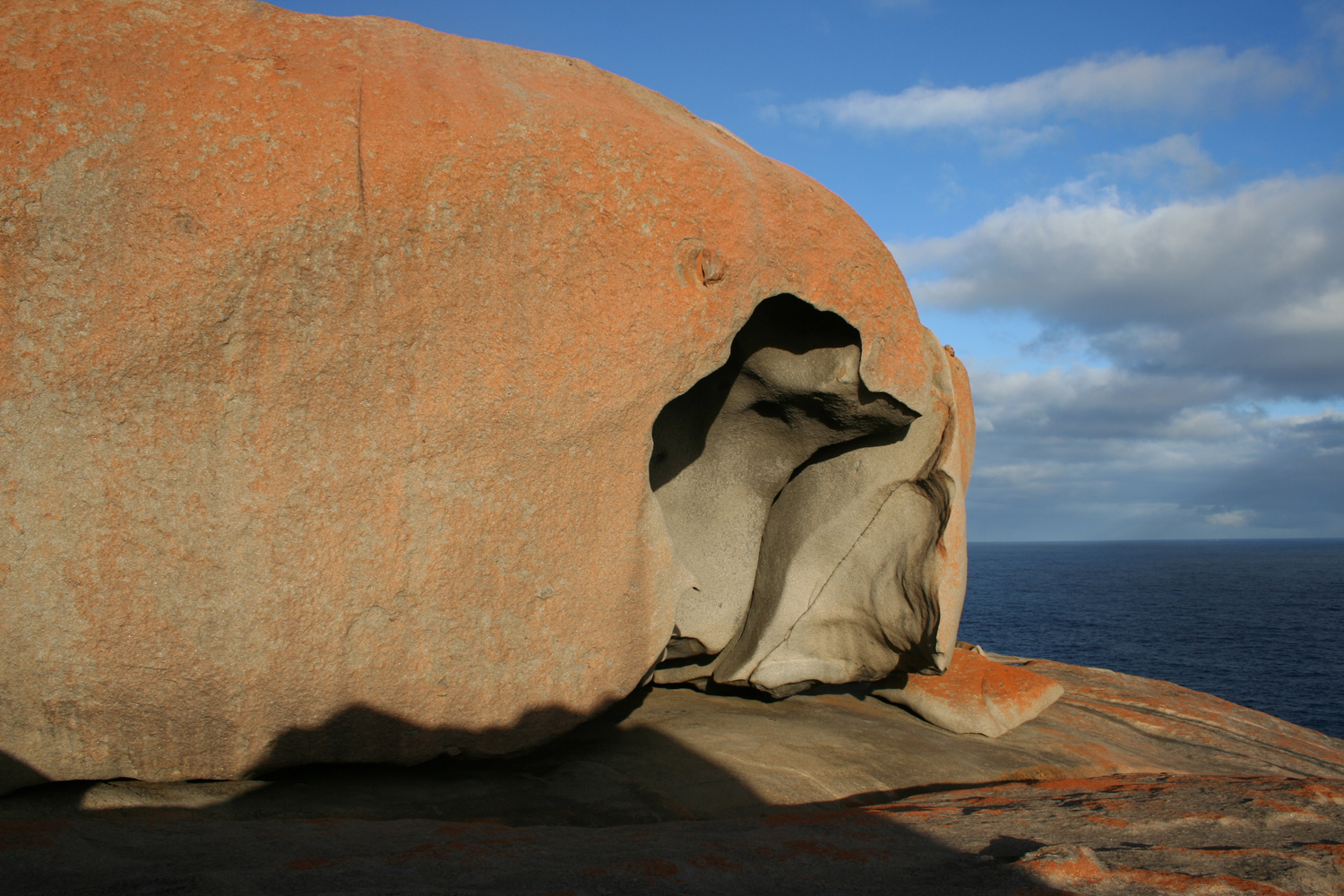
Supper
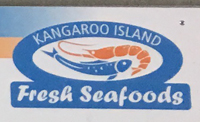
On the wall was a very useful poster listing and illustrating everything Australian waters offered to consumers, and a couple of fellow diners obligingly leaned back from their suppers so I could lean over their table to get a good shot of it. Most importantly it showed us what the Moreton Bay bug looked like that we'd had back in Uluru. It had been digested long ago but it was still a little bit of a relief to see how much more like a lobster it looked than a cockroach. The marron was delicious, and we were most of the way through it when a couple came up to us and asked "Are you having the marron?" "Absolutely. It's delicious!" "Then you must be Richard and Claudia." I'm still not sure what this said about our predicability, the small-town effect of everyone knowing everything, or Lyn and Graham's long experience of tourist behavior, but I took an instant liking to this couple who chose to introduce themselves in this "Doctor Livingstone I presume?" fashion. They were Peggy and George Gehring, and I don't know why they stopped in because they could not join us—they had an appointment for supper back at Stranraer. But we were delighted that they did, and they made very pleasant company at breakfasts and dinners over the next couple of days. |
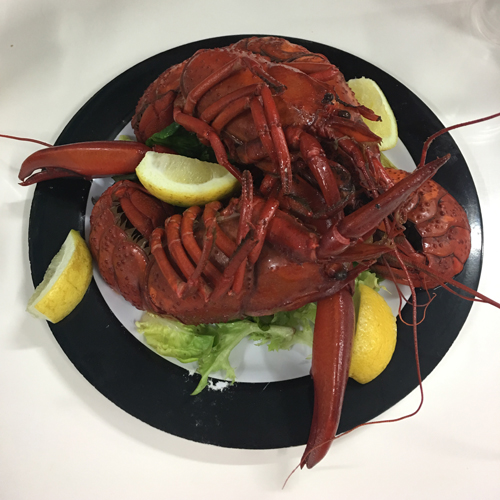
|
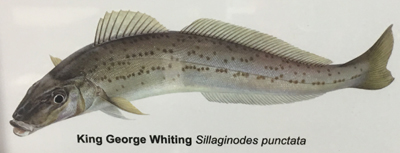
Supper over, we eventually followed Peggy and George back to the homestead. As we walked through the door, Lyn was there to greet us. "I've got a bone to pick with you!" "Me?" "Yes, you! Luke was here at lunch time to pick you up!" The blood drained from my face. I felt sick. The most expensive day in the whole trip, and I'd blown it by screwing up the date? Before we went any further I needed to know the truth. I scurried back to the room to check the itineraries and invoices binder. It didn't really matter if it was my mistake or theirs, but somehow knowing it was not my screw up would help. It would certainly help with the money. But of course it was my screw up. The worst part was that all it would have taken was a quick confirmatory peak the night before. God knows I'd done thousands of those in the months leading up to the trip, but that was part of the problem: the itinerary was so well-worn I could recite it from memory. There was no need to check it. I found Claudia and Lyn in the kitchen. "My mistake entirely." "Well" she says. "Luke and I discussed it, and he's managed to clear his schedule for tomorrow, but if you want him to come, you need to call him and confirm it." She even dialled the number. Wow. Like I've always said: Murphy delights in making sure that every little thing that can go wrong, does go wrong, but when it comes to the big stuff he's just as consistantly allowed me to be lucky. Claudia just shook her head.
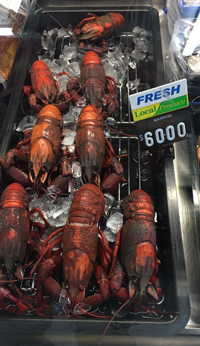
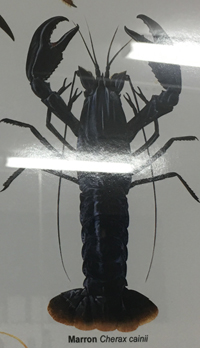
Crisis averted, I felt like a limp rag, but there was one finally treat for the day: Graham's night tour of the property. Another couple joined us (who?) but they were gracious enough to grant me shotgun. Claudia of course wanted no part of me being seasick again, but nevertheless it is a sacrifice sitting in the back. There is just not the same amount of glass to look through. So I feel at least a little guilty. I made up for it in part by jumping out and opening and closing gates, which I know the others would not have done, for a variety of reasons.
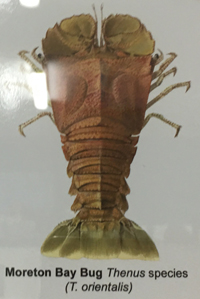
"See these?" Graham asked as he drove over them. "Scottish thistles. We wish they would take them back." Sure enough the field was liberally sprinkled with them. By way of idle conversation having seen them during the day I observed that "the Cape Barren geese leave a close-cropped lawn." Graham: "Yes, like your Canada geese, and about as welcome."
The most surprising part of the adventure was that we did not see any sheep. Clearly that was by design, but who knew how easy it was to hide six thousand sheep on a 3000 acre farm? We did see a bunch of wallabies, and Graham regaled us with stories of the homestead where he had lived man and boy.
Day 2: Kingscote
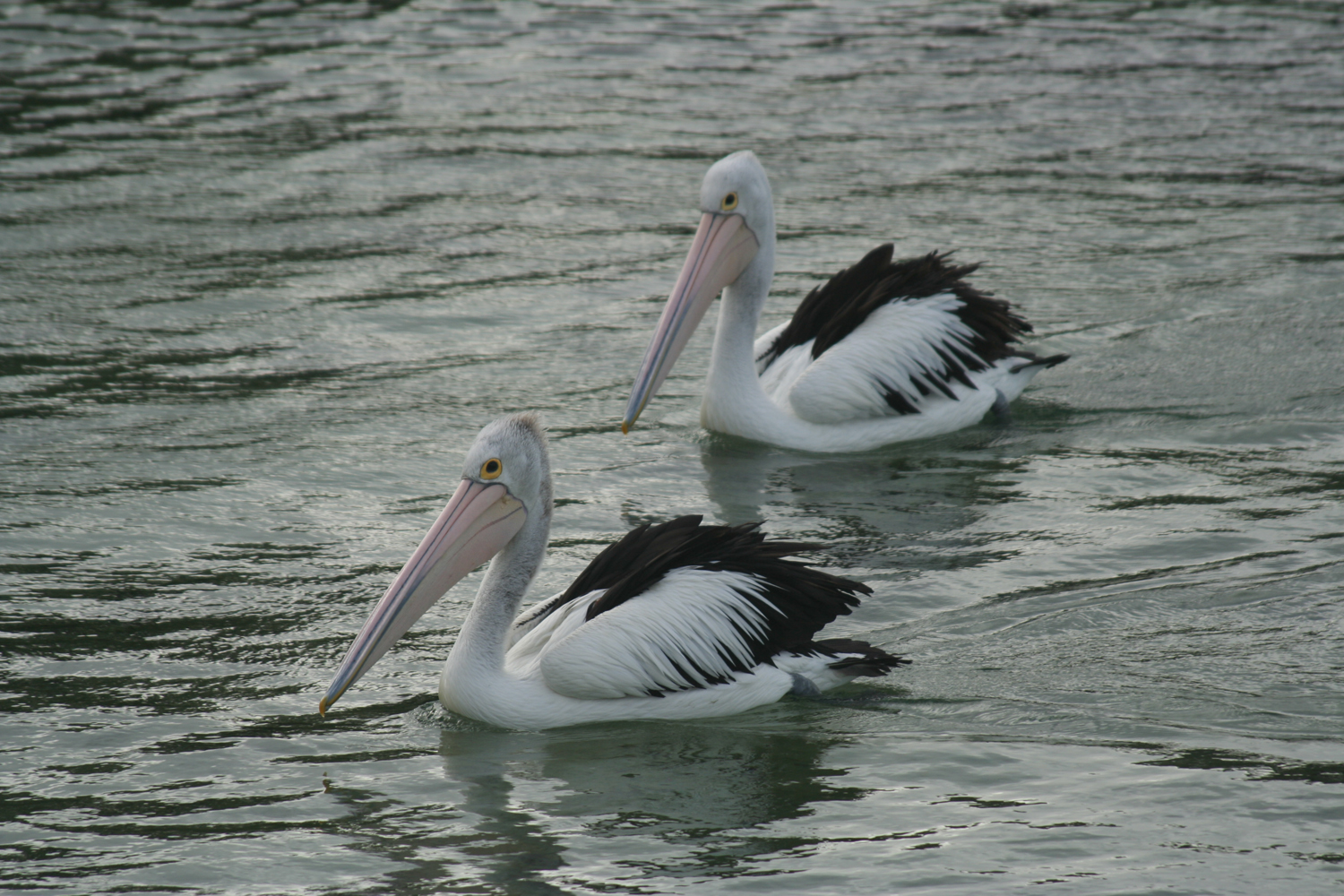
| The custom itinerary for our guided day combined elements of the day tour and the night tour. To achieve this, we were not being picked up until lunchtime, and then instead of the obligatory picnic lunch, we would have a picnic supper, followed by the night excursion. Part of the re-negotiated deal, and a very small price to pay I felt, was that we would need to pick up an additional guest after supper, who would share the night time section with us. No problem, especially as we were still following our itinerary (as long as we got to pick her up and not the other way around—it would be harder to give up the shot-gun perch than the privacy). 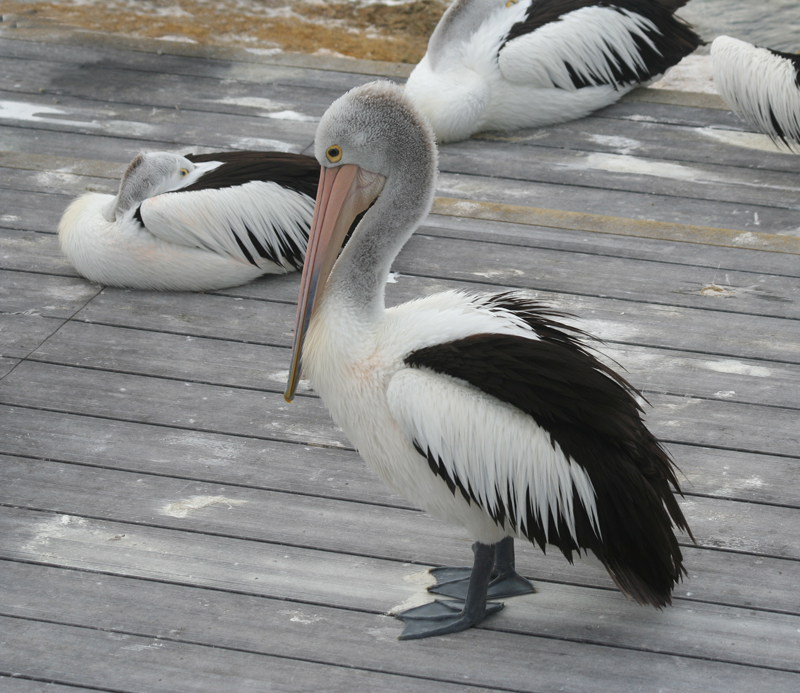
|
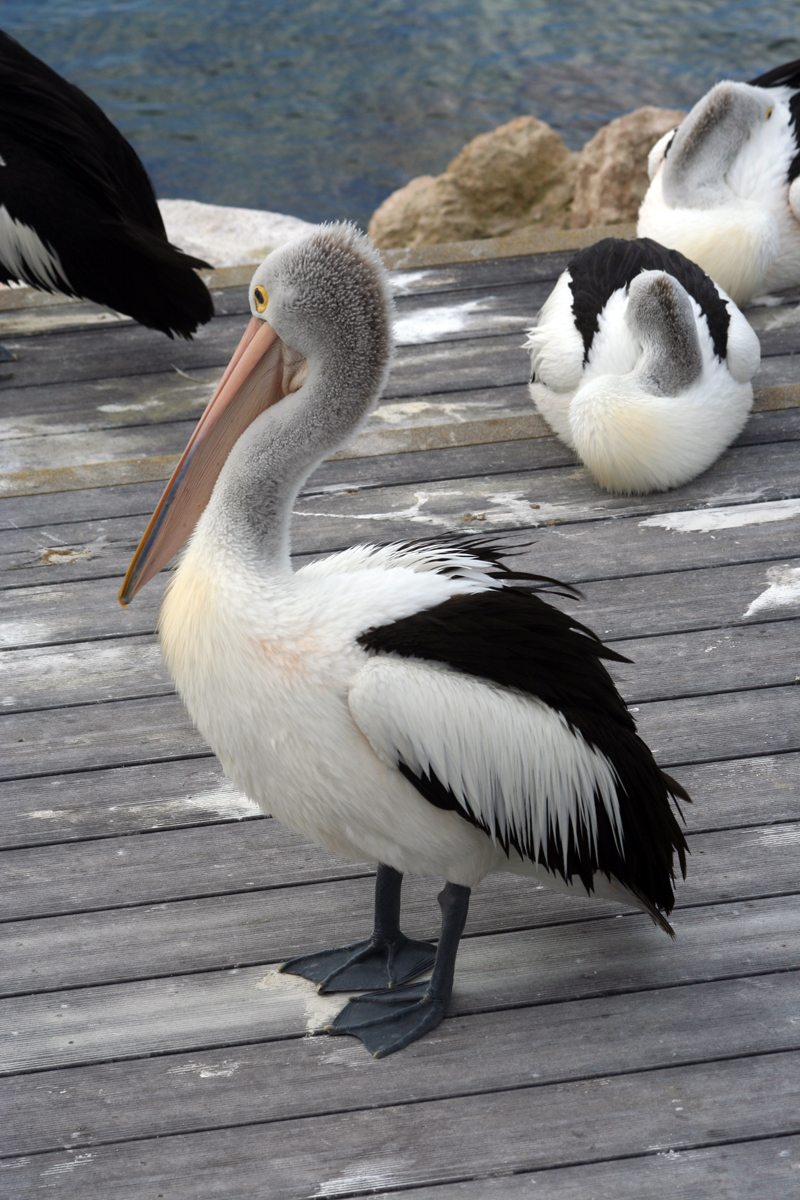
|
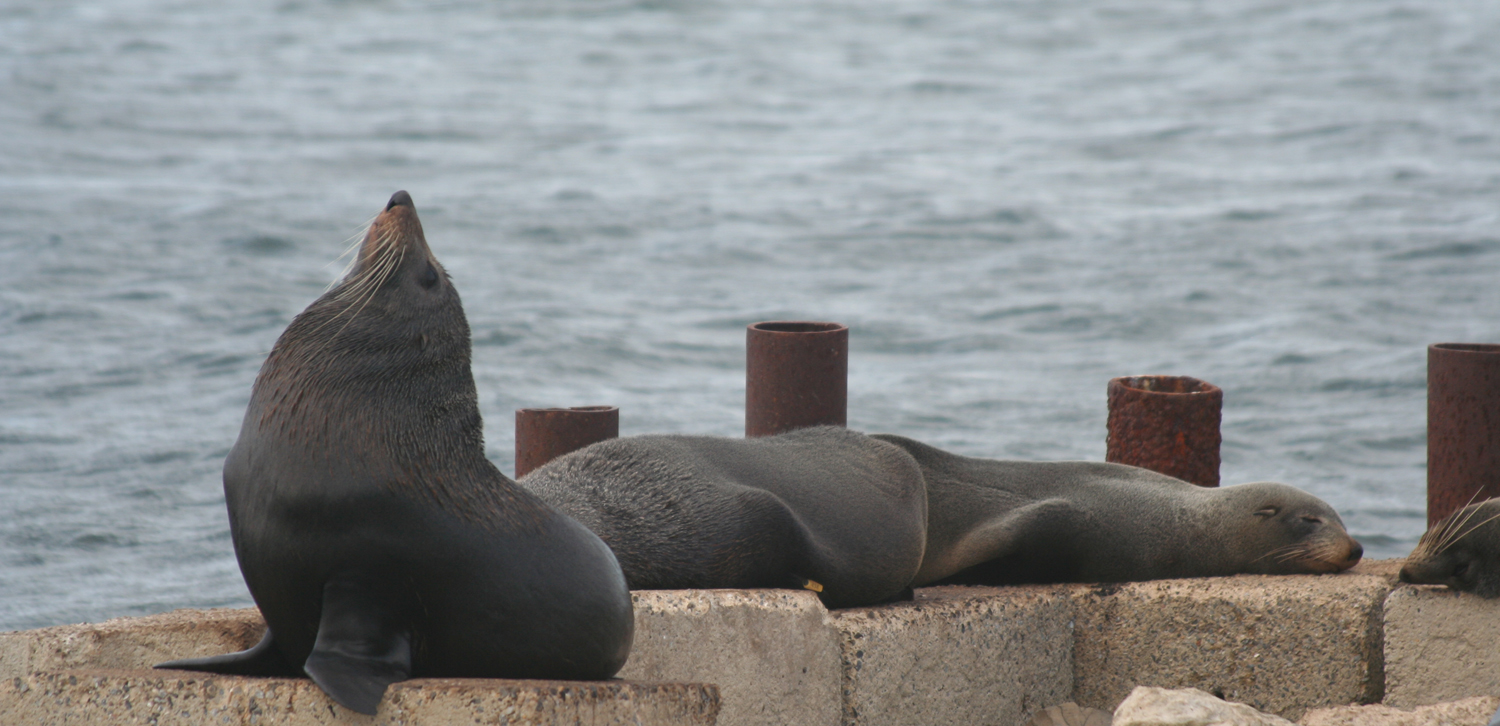
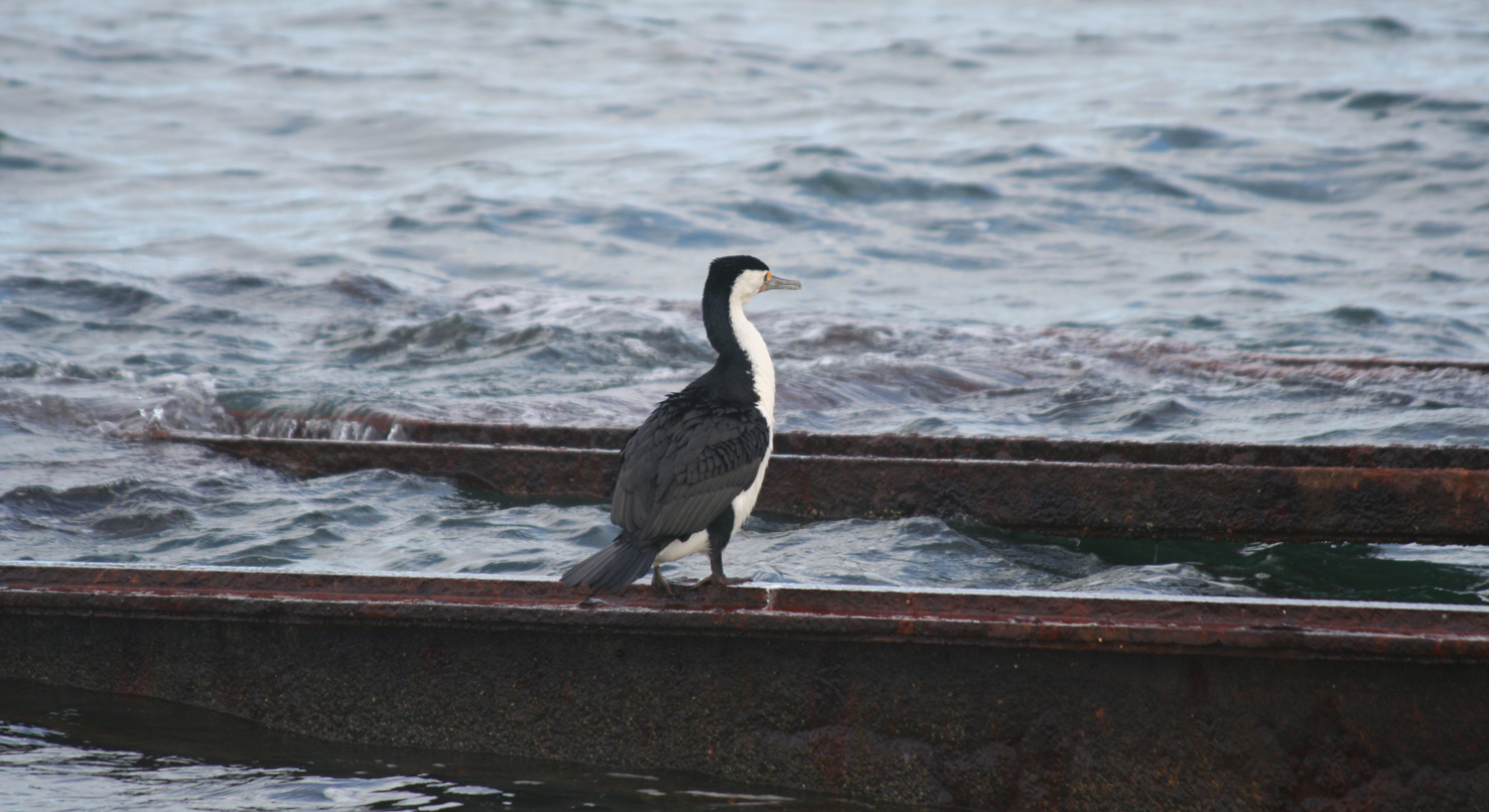
 Janet Aycliffe.
Janet Aycliffe. Digital print with solar plate etching over the top.
Photopolymer etching (modern version of lithograph).
This left the morning open, so first stop was the barber shop in Kingscote. Lyn called during breakfast and lo, there was a slot right at opening time. It was a good half hour drive, so we got started fairly promptly, and were parked in the main street a few minutes before 9am. By 9:10am I was on the street again, sporting my $20AUS #1 cut. "No thank you sir, we don't accept tips." We had a wander around the souveniry places, which we can now do in seconds, but then stopped in a little art gallery to see if they might have something more special for my indigenous animal quest. Nada, as usual, but lots of other lovely things. I knew we were in trouble when we stopped a few yards down the street after leaving. We'd both been taken by the same artist, though not the same piece. Nevertheless it was a sign. Half an hour later a deal was struck, we became the owners of a Janet Ayliffe photopolymer etching. Sounds weird, looks amazing. While they prepped the piece for transport, the galley owners lent us a courtesy card to visit the coffee house down the street. It took a while to make it, but OMG it was a great cup of coffee. I had a cappucino that instead of grated nutmeg or chocolate had freshly crushed chipotle sprinkled over the foam. Enough to give a little endorphin rush to go with the caffeine kick. Fiendish. And de-licious.
The morning had marched on and by now there was not a lot of slack, so we headed on back to Stranraer to ensure we were in good time for our rendezvous with Luc—we had no intention of keeping him waiting again.
We were overtaken by a pickup doing at least 100kph, with a dog loose and wandering about in the back. He took the trouble to lean over the side to yap at us as he went by, then returned to his spot leaning into the cab at the front corner so he could stabilize himself and peer around the cab with his head in the wind.

Private Tour
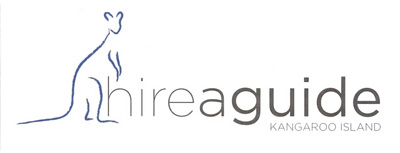
Luca was, as should be expected, a few minutes early. Except that we were now able to confirm that we had not been mis-hearing: this was not Luca, the boss, with whom all negotiation had been made, but Luke his stand in. No worries, as a native he had a much greater command of the English-language in general, and Aussie humor in particular. Lead on, MacDuff.
We reinforced a few rules/expectations: we wanted to go to places we could not get to, or would not know about, if we were not under the guidance of a local professional; we were well aware of, and comfortable with the ecotourist risk that as not-a-zoo, nothing was guaranteed, we could see more than we bargained for, but more likely we would see less than we'd hoped; and lastly by definition we absolutely did NOT want to see any of the must-see tourist attractions (or their tourists). "Right-oh."


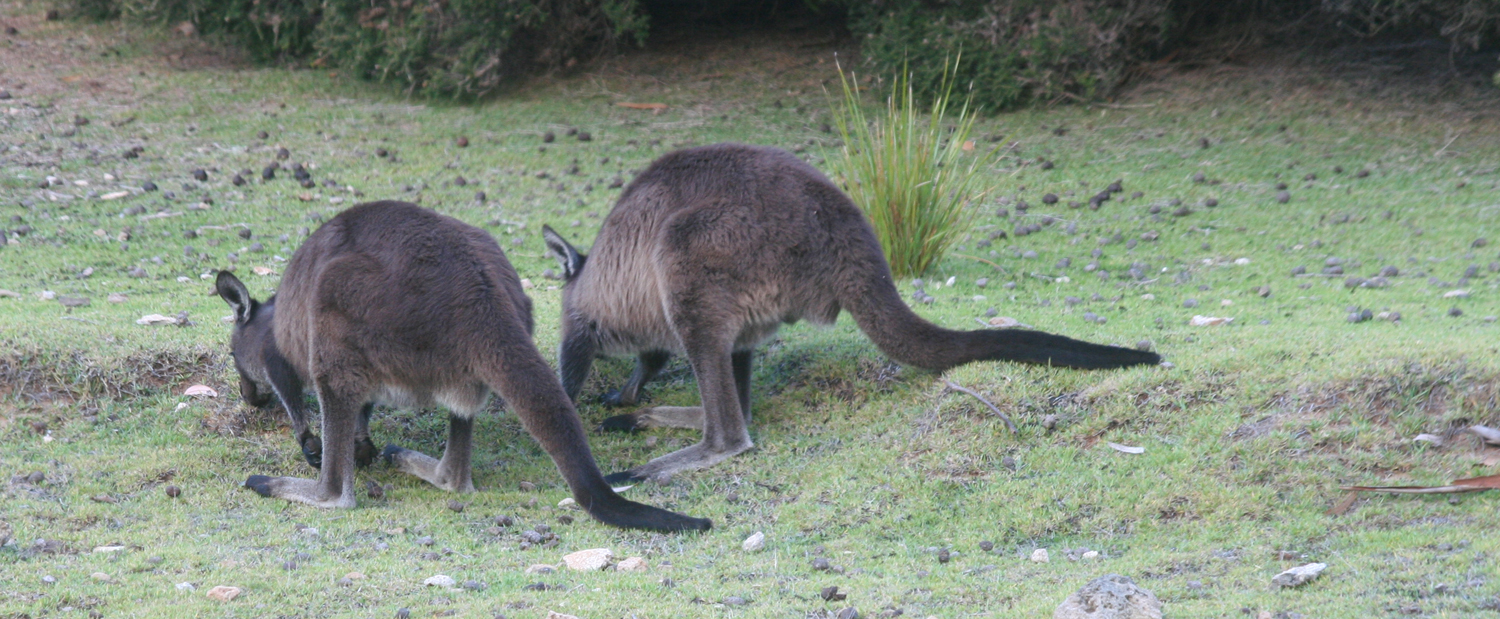
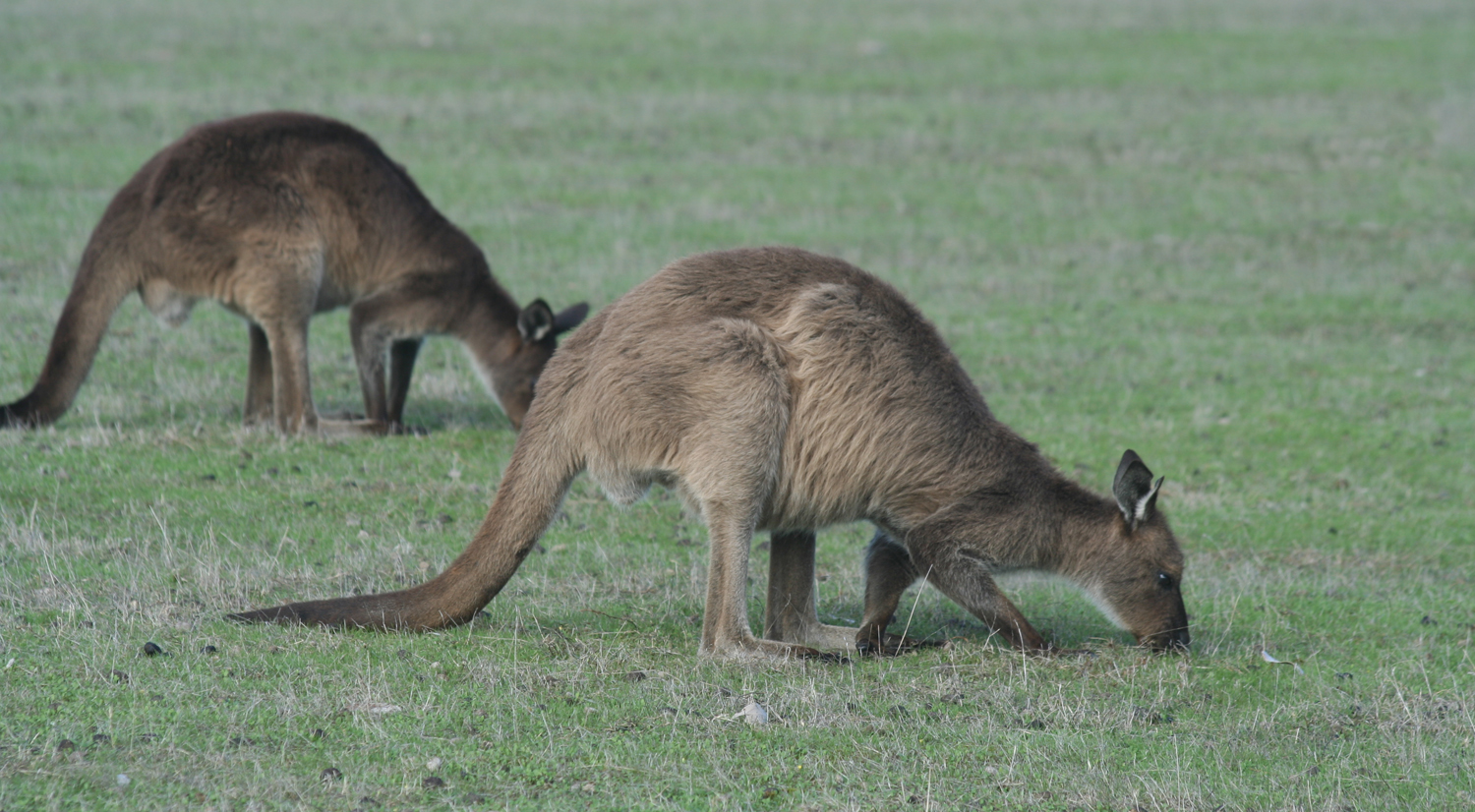
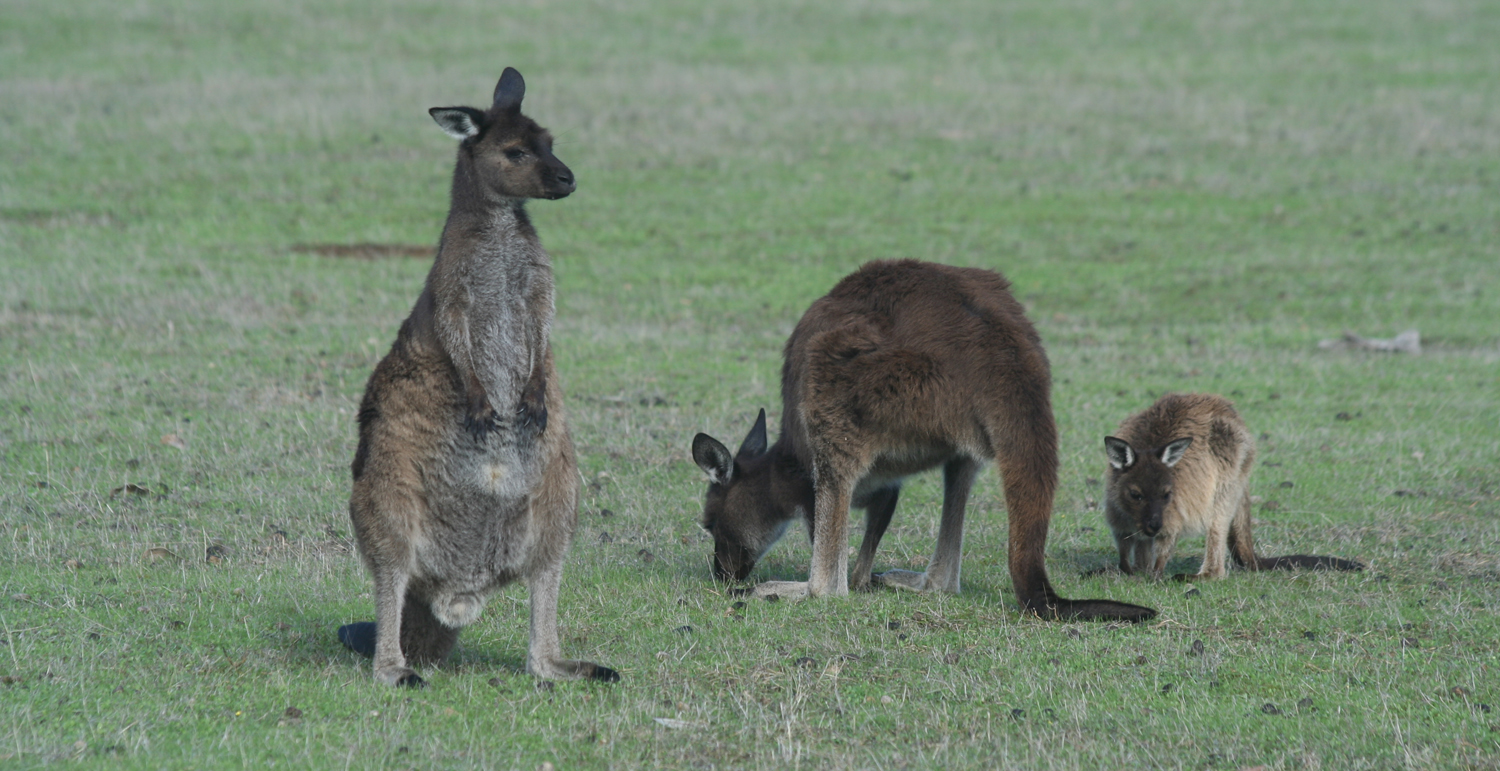
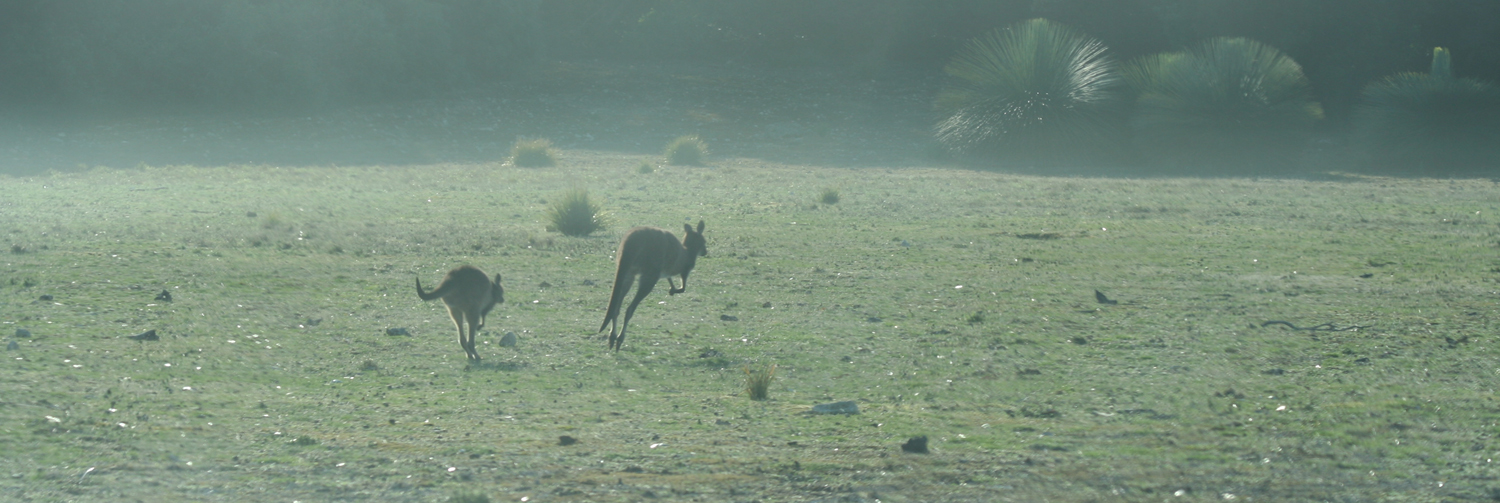
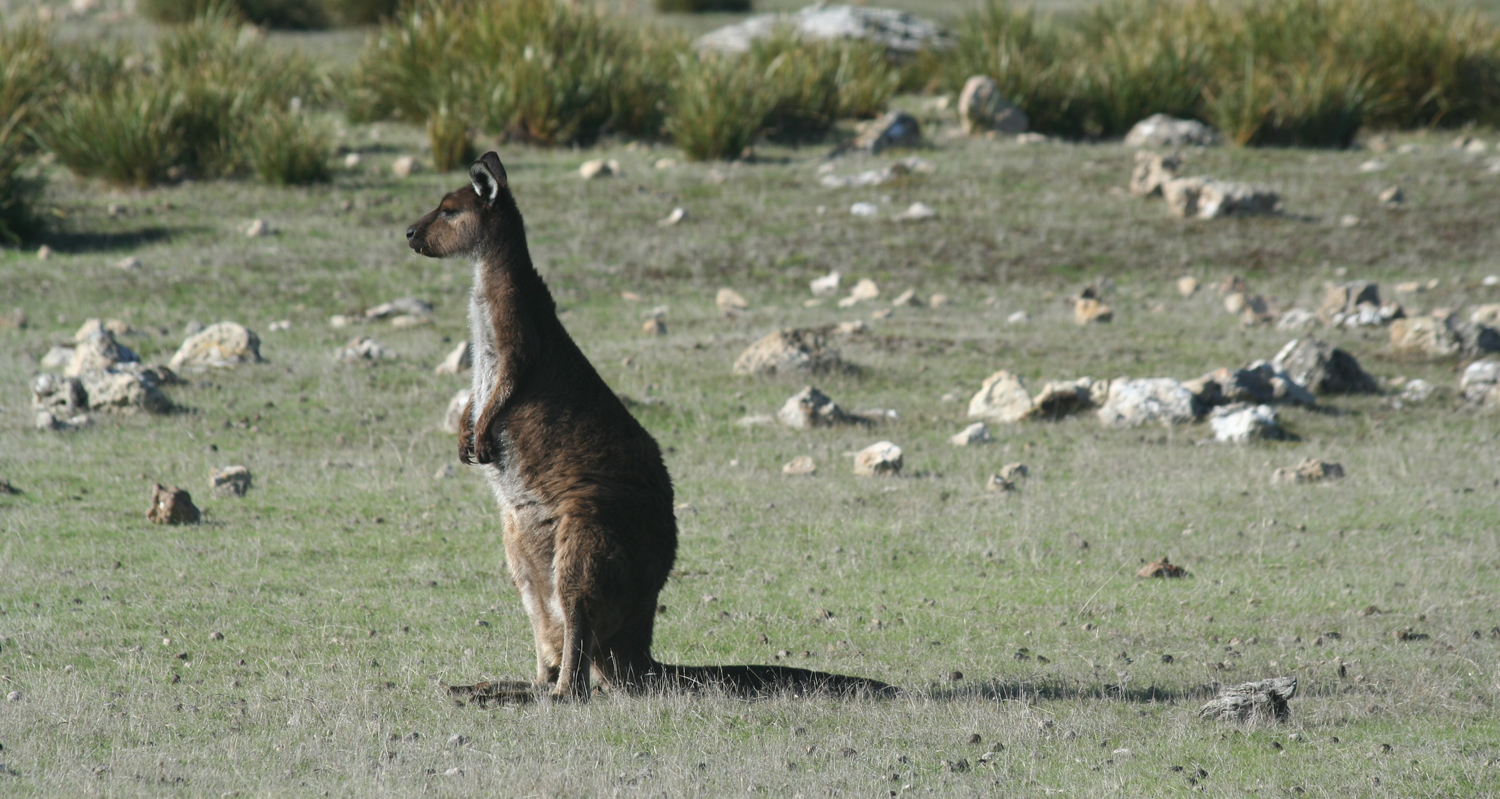
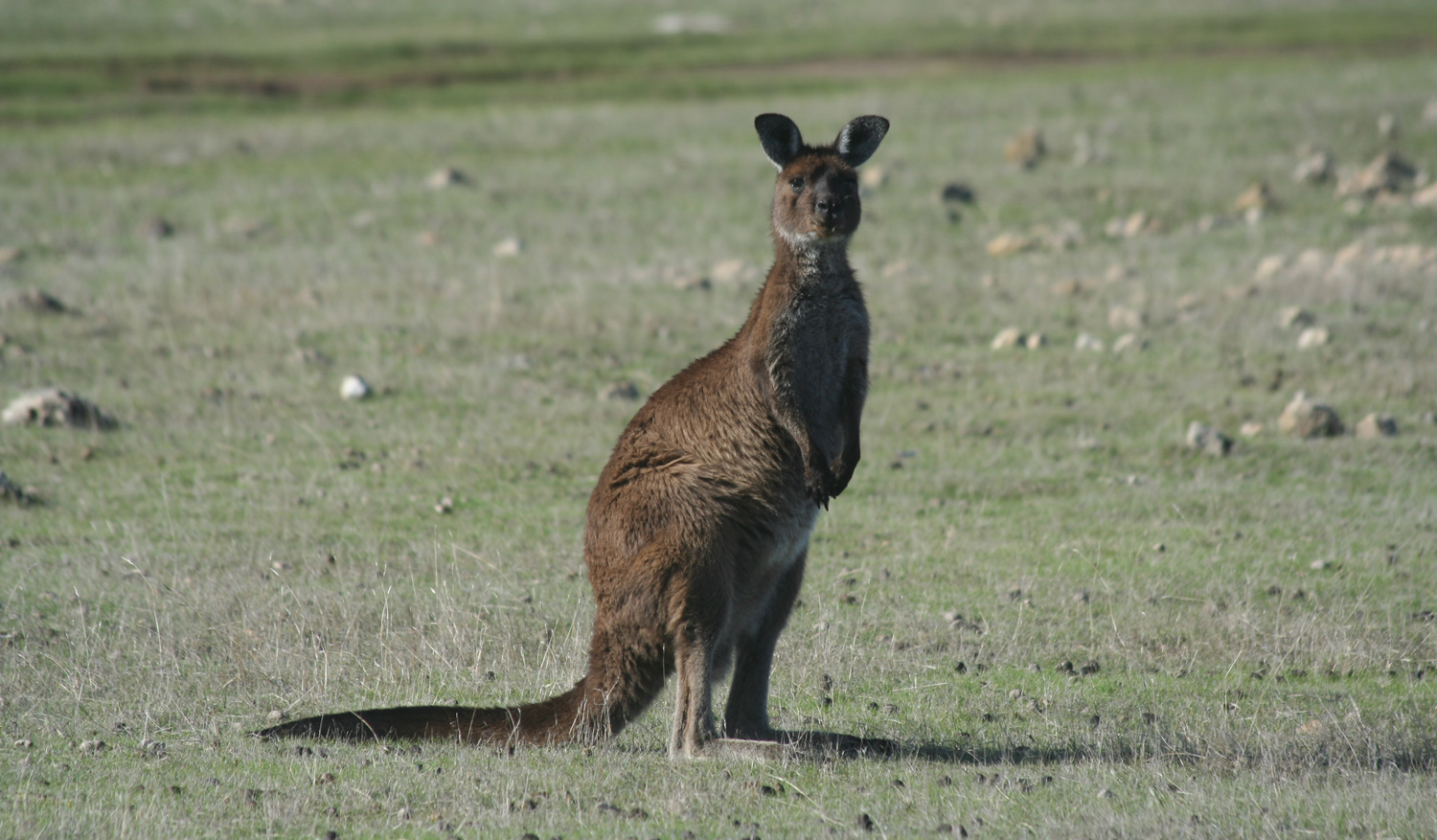
We duly sailed right passed the entrance to Seal Bay, and pressed on towards the far end of the island. In the middle of nowhere (perfect) we pulled off the road in front of a locked gate. A severely locked gate. There must have been ten padlocks on the chain. But this was a cunning plan. Each of the owners of the ten padlocks could open their lock and thereby open the chain's loop. So any one of them could get through the gate, but noone else could. I locked the gate again, jumped back in the truck and we drove about half a mile into the bush, until we came to a clearing that must have been four or five hundred acres. And it was peppered with kangaroos. "A mob. That's the collective noun for roos."
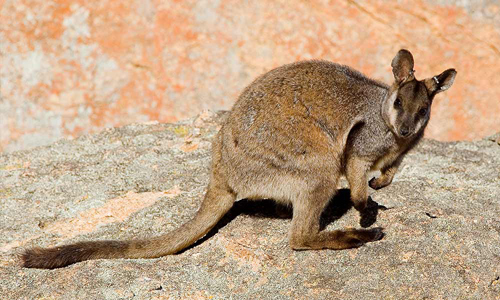 A wallaby (a black-flanked rock wallaby to be precise), stolen from the interweb to illustrate the
A wallaby (a black-flanked rock wallaby to be precise), stolen from the interweb to illustrate the difference between kangaroos and wallabies (in addition to one being out in daylight so they are
easy to photograph and the other at dusk when it is impossible). Note the much stockier tail on
the kangaroo, enabling it to comfortably sit upright using its tail as the third leg of a stool. Indeed
they can shuffle forward in that stance, lifting both feet off the ground and rocking forward a few
inches before planting them again and then drawing the tail up behind.
We spent a long time here. It was magical. I think Claudia could have stayed all day. Luke told the story of the land. A woman and her sweetheart had bought the property had cleared it by hand, and once cleared started to farm it. They had a son. Life was bliss. But with the boy still young, the sweetheart collapsed and died. The widow continued to farm on her own, and to raise the boy on her own. The years went by, the boy grew up, and the woman grew old. The boy couldn't wait for the old woman to give up so he could sell the land and move on. So she bequeathed the land to the island to be used, exactly as we were enjoying it, as a sanctuary for the native animals and those who love them. The boy got nothing.
It was a perfect spot, and a perfect time. If the weather was hotter or colder, the kangaroos would have kept closer to the trees. But in this perfect Goldilocks temperature they were out in the open grazing, snoozing, and occasionally treating us to my favorite, the apparently effortless bouncing from one area of the park to another. It is thrilling to watch any animal at full gallop, but there is nothing like the perpetual motion machine of a marsupial bounce which seems to leave more energy in the system after each hop.
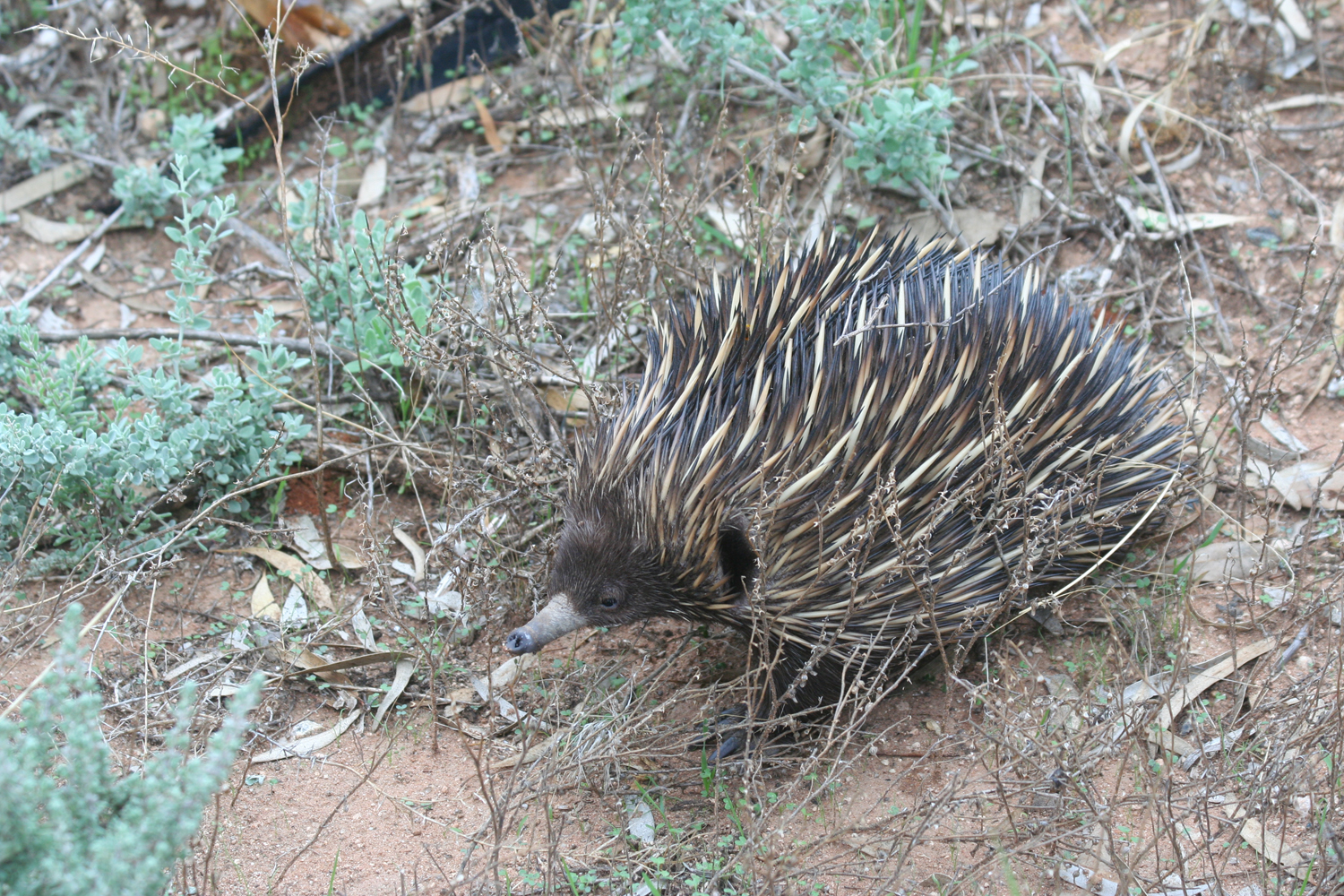
Finally it was time to move on, and we drove through several other paddocks without seeing anything before we stumbled across a reluctant echidna who tried hard to stay off-camera, but eventually gave up an ass-shot while he buried his good side into a large tussock of grass. Honor satisfied on both sides we called that a wrap and moved on.
We stopped for a few minutes to see another echidna safely across the road, but mostly we pressed on to cross to the north of the island, in an attempt to get to the next stop at dusk. Luke pointed out new plantations, and occasional scarred and scrubby paddocks, evidence of the 2007 catastrophic fire event.
Lathami Conservation Park was formed on 1 October 1987 to protect an important nesting and foraging habitat for the glossy black-cockatoo (Calyptorhynchus lathami halmaturinus) an endangered species that only occurs on Kangaroo Island, and in 1995 the population was less than 200 individuals and declining. A recovery plan was implemented and the population is now increasing slowly. Sure enough a small flock flew by in the dusk. They were clearly cockatoos, but their location was better evidence of their species than anything we could see in the gloom. Luke was confident, so we counted the sighting. We spent about half an hour carefully poking around the scrubby woodland but could not find their roost.
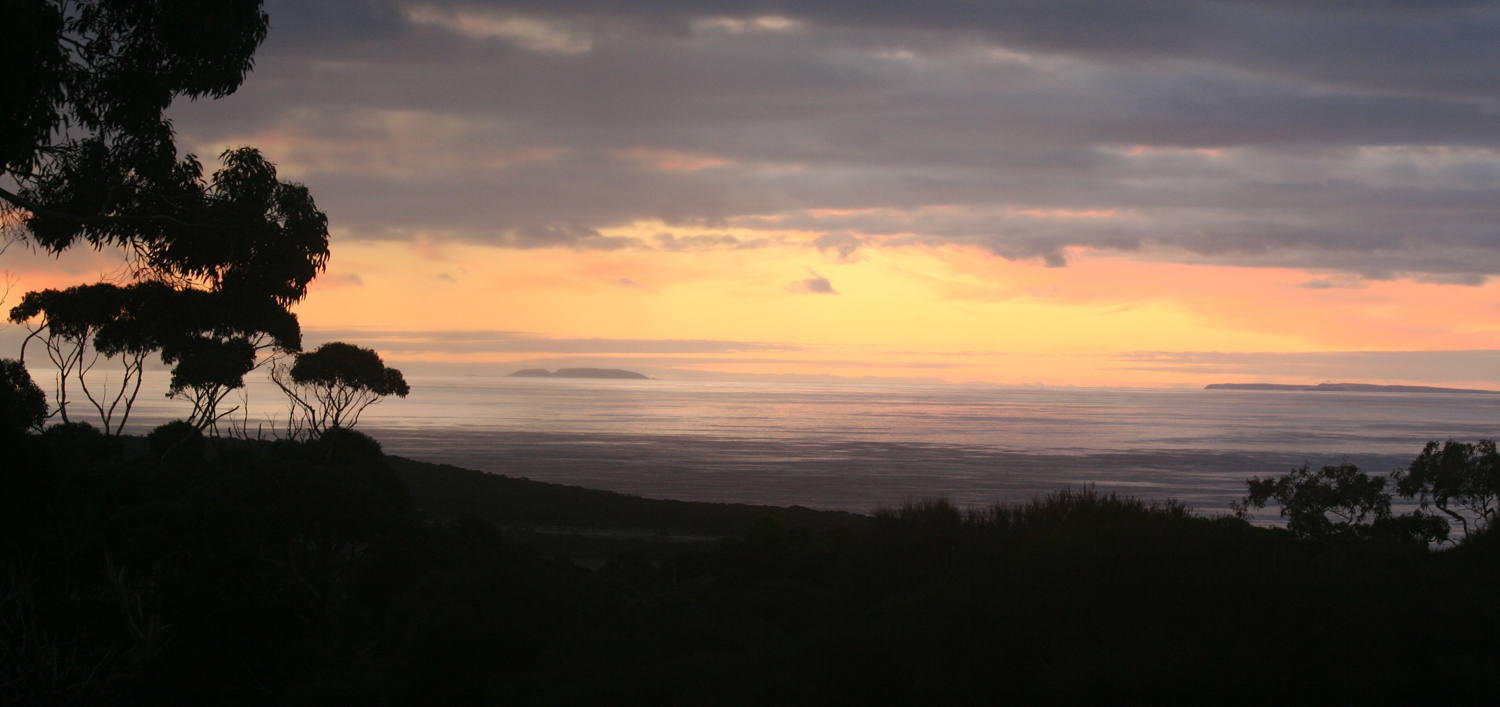
It was a fairly long drive back to Kingscote, but that's where we needed to be for penguins, to pick up our additional guest, and last but by no means least for our picnic supper. As we were to be reminded later back in Perth, Australians are serious picnickers. So we pulled up at a spot in a park near Kingscote, right on the water. There was an open barn with multiple barbecues under the roof. All you had to do was wipe off the grill plate to your own cleanliness standards, and fire up the municipal propane. Claudia and I took a stroll up the beach road while Luke cleaned up and laid the table. As our fresh caught King George Whiting was grilling, he opened a bottle of red, and prepared a green salad. With neither Luke nor Claudia drinking, I felt a little sheepish chugging on my own, but I managed to get through a couple of glasses without feeling too guilty. The food, of course, was delicious, the whiting reminding me of a long thin tilapia fillet, firm but not flaky. And the flavor was enhanced by the whole spectacle of having a personal chef prepare your food in front of you. Al fresco.
Luke cleaned up, I finished my second glass, and it was time to pack up and go collect our additional guest. She was fairly young, fairly quiet, and fairly unmemorable, but on the other hand she was here on KI, she had the imagination to discover and reserve a spot on this way less than popular tour, and she was happy to muck in with us. We had a blast. Luke took us on another cross-country night tour where we not only saw wallabies and possums but Luke found a spider in a web so large that when he picked it out with his handheld spotlight, she jumped out simultaneously with me to get a much closer picture.
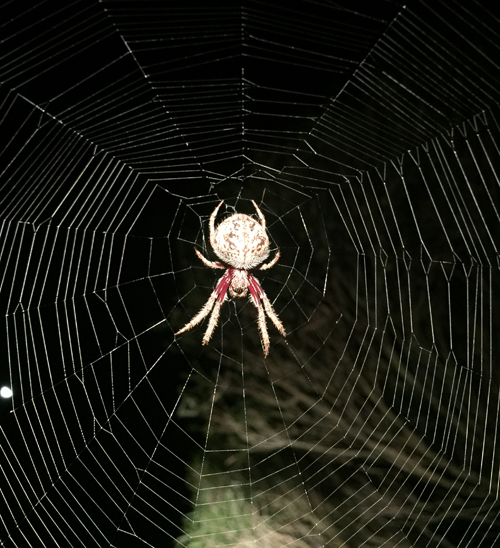
Then on to the star attraction. I was a little disappointed in the first location I have to say, right underneath a highway bridge. But sure enough, tucked deep in their burrows we were able to spot several penguins staring back at us. We moved on to a second more "natural" location, in the scrub bushes between a housing complex and a beach. This time we could hear them squabbling, which made it a little easier for Luke to find the occupied burrows. Not quite as fabulous as watching them come home from the beach as we had in ... but easily made up for by the fact that they were rumored not to be there at all. Score.
We had an interesting conversation with Lyn and Graham about the seal / penguin story. It is a fact that the local penguin population has crashed. It used to be a popular tourist attraction, but not any more. Many sources said they are gone, gone, but others claimed that there are some left, and that was a major objective for our carefully structured private tour, to be out at the right time, and with a guide who felt s/he could find them for us. But back to Lyn. It is common knowledge that the booming seal population is directly responsible for the collapsing penguin numbers. "But," says Lyn "you were on the beach this morning and where were the seals?" "On the beach of course: that's why we were there." "Right. And when will you see the the penguins?" "Tonight after they come home from a day out at ... oh, I see where you are going. Right, if they are on opposite cycles, when do they meet to lunch or be lunch?" "Exactly. Meanwhile, another theory is ferral cats. Now those really are a menace." Graham agreed. Every farmer knows about them, and has seen them. It turns out they are eating a lot of things, but post-mortems have never revealed penguin remains in their stomachs. There are schemes to try to control their population, but again the experts are condemned for their ineptness. They talk of fences and poisons and "all sorts of nonsense that has been tried before and proved to be either useless or too indiscriminate. All you have to do is put a small bounty on tails, and every kid on the island will comb every inch of the island."
In my notebook I made a connection between this local wisdom and things we'd heard about global warming, but I can't remember what this was ..?